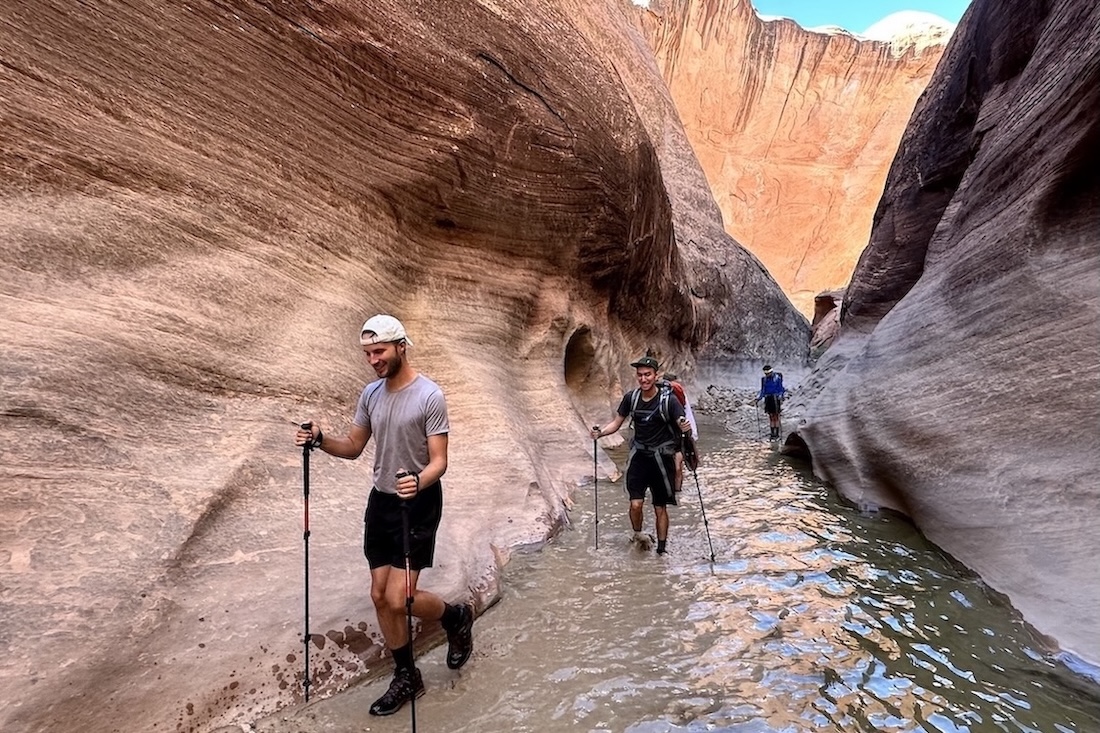
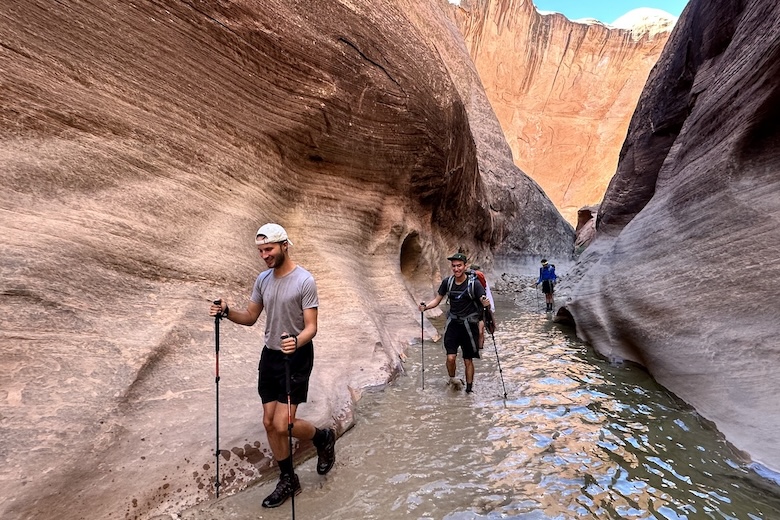


As hiking footwear continues to move away from bulky boots towards lightweight trail runners, hiking shoes have become increasingly streamlined while still impressively capable. Often made with similar materials as mid-height boots—but with a lower collar and bigger emphasis on flexibility—shoes are easier to break in while providing enough stability for most people and uses. And for shoulder-season hikes, stream crossings, or muddy outings, waterproof hiking shoes can be an excellent choice. Modern waterproof membranes and materials add negligible weight to the shoe and are more breathable than in years past. Our team of backpackers and hikers tested a range of waterproof hiking shoes (including some crossover trail runners) to find the most breathable, reliably waterproof, and comfortable options for ventures from fast-and-light outings to multi-day backpacking trips. For more background information, see our comparison table and buying advice below the picks, along with details about our testing process. If you prefer the added coverage and support of a mid-height design, we've also put together a round-up of the best waterproof hiking boots.
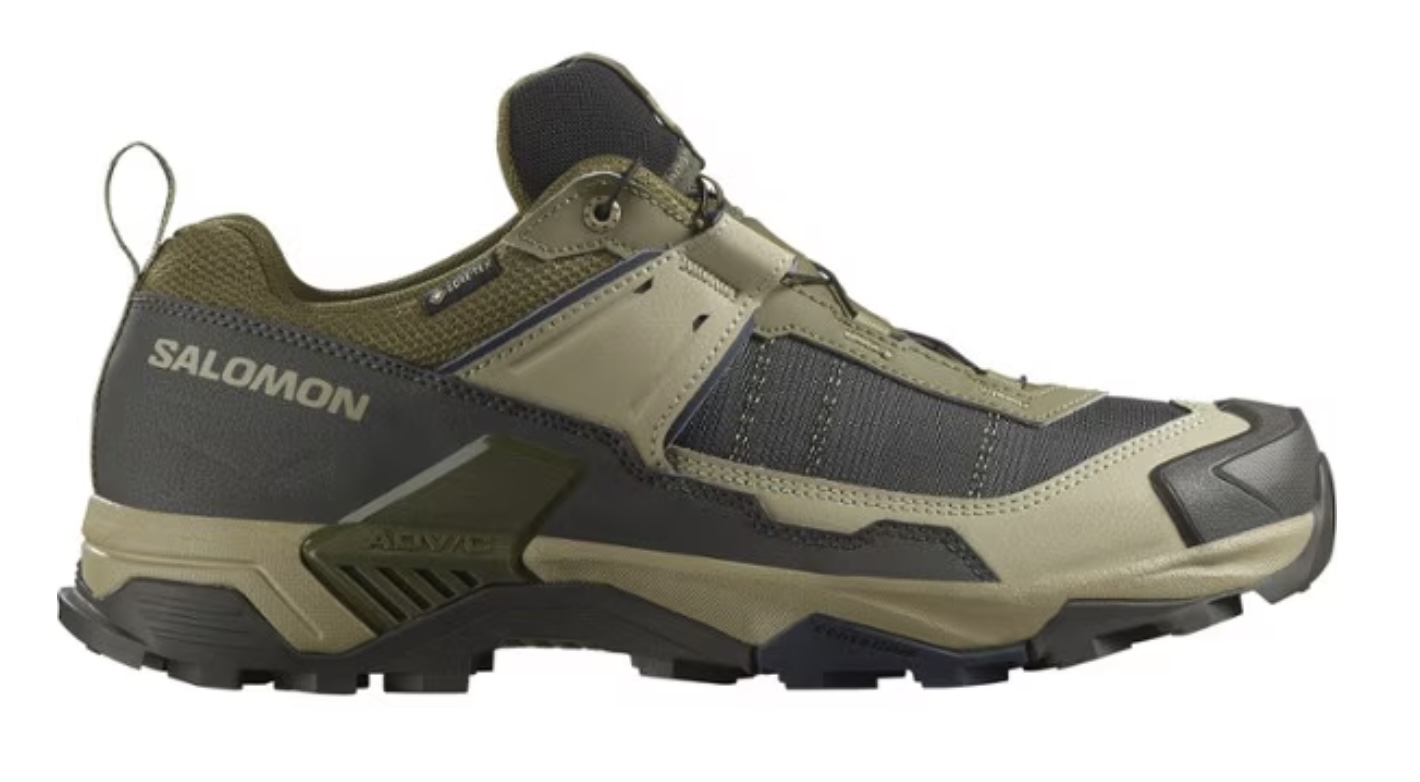 Category: Hiking shoe
Category: Hiking shoe
Weight: 1 lb. 10.8 oz. (men's), 1 lb. 6.6 oz. (women's)
What we like: Great balance of weight and on-trail performance.
What we don’t: Not quite comfortable out of the box; Quicklace system can make it tough to dial in fit.
Salomon’s X Ultra has been one of our favorite hiking shoes for years, and the fifth iteration of this classic offers a redesigned and Kevlar-reinforced upper and continues our top-rated combo of trail performance and durability. The 5 keeps the last update's revised lacing system and chassis while dropping a bit of weight, and the softer ankle padding and higher collar are positive upgrades for long missions. The X Ultra hasn't lost its mix of agility, support, durability, and protection, and while it isn't as plush as offerings from Hoka, the midsole offers adequate cushion and protection when hiking over rocky terrain. And as a final plus, Salomon now incorporates a PFAS-free Gore-Tex waterproofing, which is free of any added harmful "forever chemicals".
This is our top waterproof hiking shoe for this year, but the fit won't be for everyone. Though a wider forefoot is noticeable in this update, we still found it a bit narrow out of the box, and it took a few days of consistent use for the fabric to stretch. We also found that the Quicklace system makes it tricky to dial in a snug fit (we prefer traditional laces for this), and we had to stop a few times on the trail to adjust things. Those with sensitive feet may also want to consider trading out the insole for softer support on long-distance days—we like adding a Superfeet insole. But overall, our impressions of the X Ultra 5 have been positive: The shoe is noticeably more hard-wearing than the previous version, and the Contragrip outsole remains one of our favorites when tackling a range of terrain. While we know many folks miss version 3 of this shoe (4 was a pretty big disappointment), we still feel that this 5th iteration is a high-quality, reliable waterproof hiking shoe for technical hiking and lighter backpacking.
Read more: Salomon X Ultra 5 Gore-Tex review (women's version)
See the Men's Salomon X Ultra 5 Gore-Tex See the Women's Salomon X Ultra 5 Gore-Tex
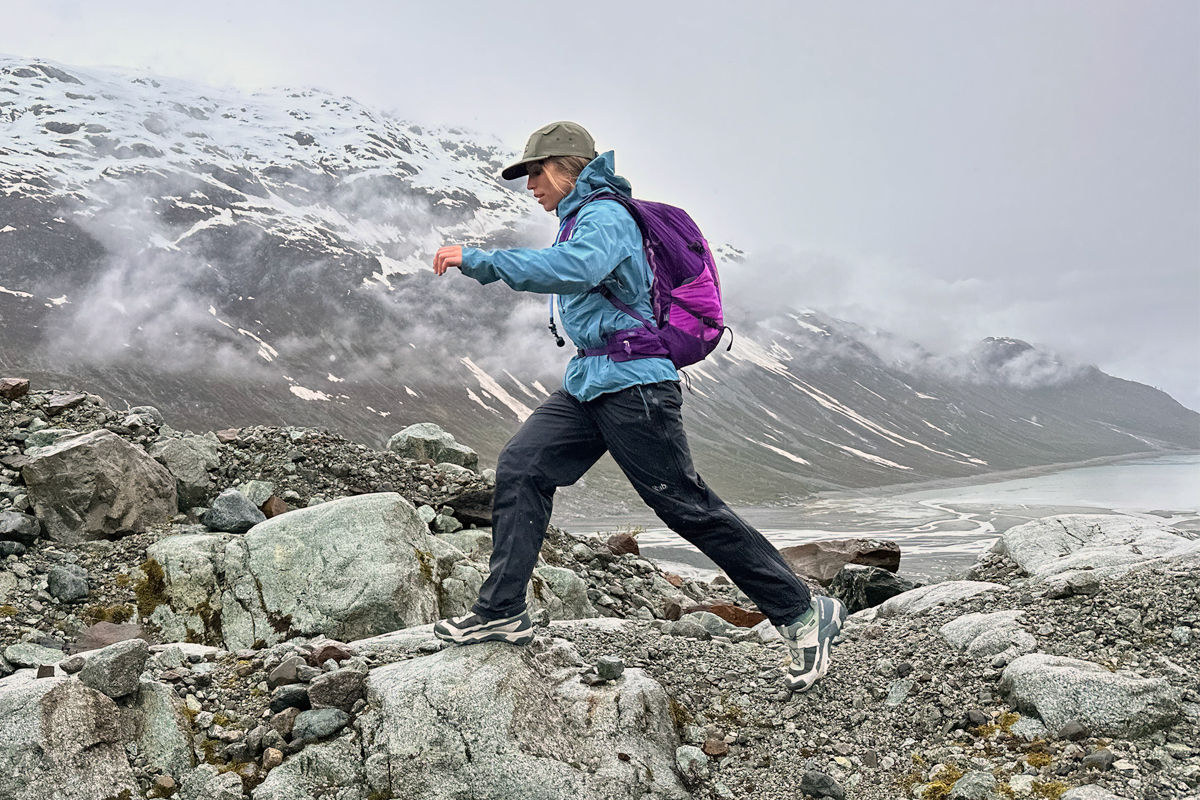
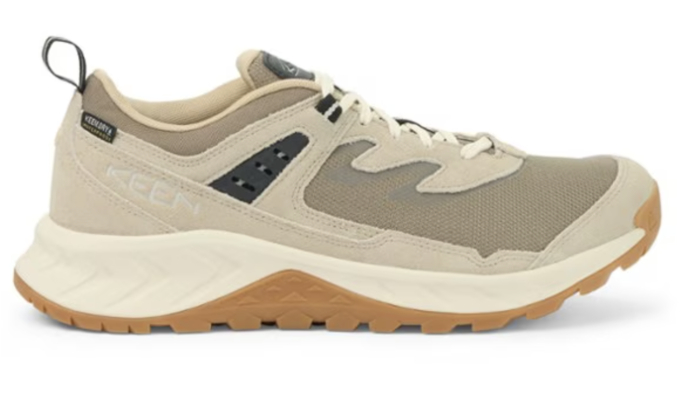 Category: Hiking shoe
Category: Hiking shoe
Weight: 1 lb. 11.9 oz. (men's), 1 lb. 7.6 oz. (women's)
Waterproofing: Keen B.Dry
What we like: An affordable hiking shoe with responsive cushioning.
What we don’t: The collar can cause ankle rubbing; less toe protection than other Keen shoes.
The Hightrail is an alternative to Keen's classic Targhee, featuring a modernized silhouette that retains the brand's signature traction and midsole in a lighter package. We found the Hightrail to be a less polarizing design than the chunky Moab Speed 2 GTX below, with a more streamlined look and very reasonable price point. Any waterproof hiking shoe for less than $150 is a steal these days, and Keen can afford to drop a few dollars here by using their proprietary B.Dry membrane instead of a costlier material brand like Gore-Tex. It doesn't impact the waterproofing, though—these shoes stay dry on the inside and have reasonable breathability to boot, though not as good as a Gore-Tex membrane.
The Hightrail comes with Keen's molded footbed for added arch support, as well as the brand's All-Terrain Rubber outsole. Keen's origins as a boating shoe mean their rubber outsole is competitive with top-market rubber like Vibram, and we've been impressed with the traction on both wet and dry trails. The upper has a high percentage of Nubuck, which is more abrasion-resistant than mesh-heavy models but can feel less breathable as a result. These shoes also don't have the same secure, foot-wrapping support as our top-ranked Salomon X Ultra 5 GTX, but for less technical trails without a lot of sidehilling or off-camber terrain, they're a solid, affordable option in a classic throwback design.
See the Men's Keen Hightrail Waterproof See the Women's Keen Hightrail Waterproof
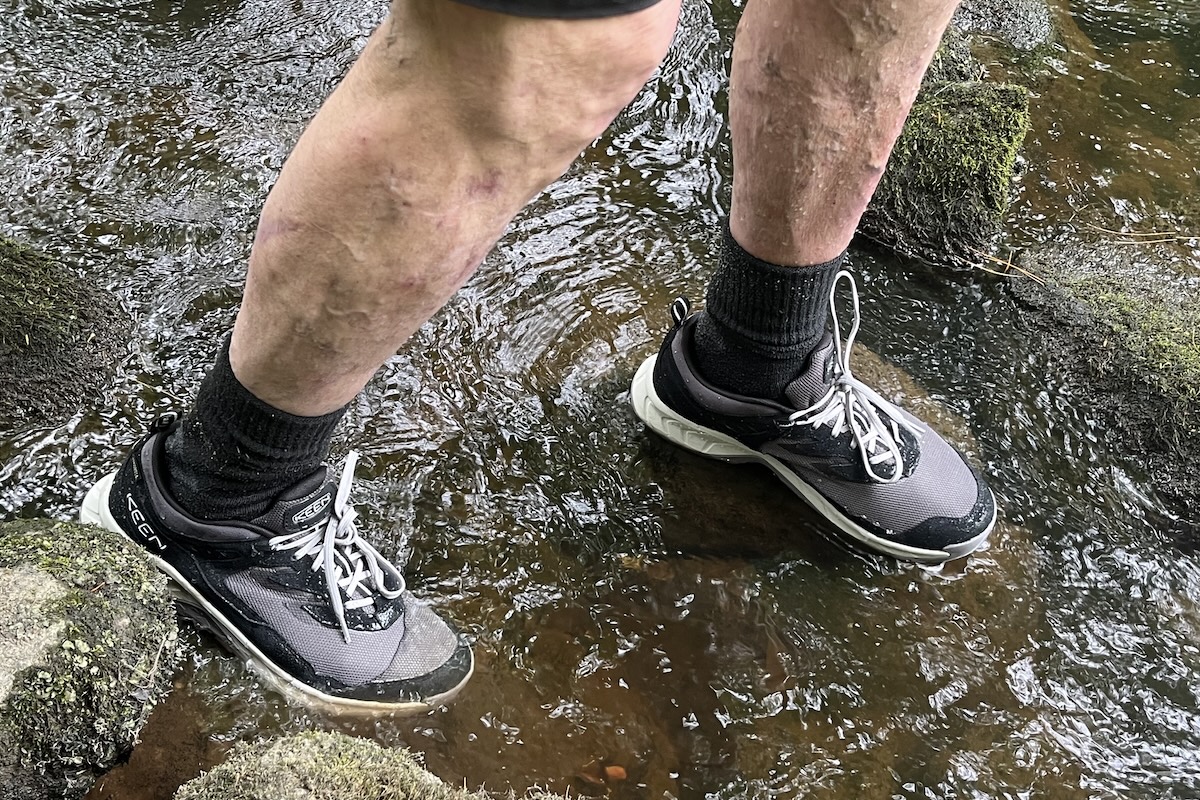
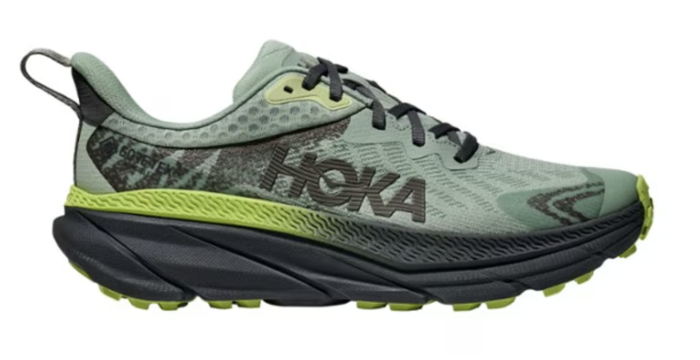 Category: Trail running shoe
Category: Trail running shoe
Weight: 1 lb. 3.4 oz. (men's), 1 lb. 0 oz. (women's)
What we like: An incredibly light trail shoe that doesn't skimp on underfoot cushioning and deep tread.
What we don’t: Not the most stable shoe on tricky footing.
One of the lightest shoes on our list, Hoka's Challenger 7 GTX underwent a pretty hefty overhaul this past season, including a more streamlined mesh upper, softer foam, and a sleek Gore-Tex Invisible Fit membrane, which uses partially recycled materials. The outsole lug pattern is also redesigned and modeled after gravel bike tires, which have variations in size and spacing in order to better handle a mix of surfaces. Smaller, more tightly placed lugs line the center of the Challenger's outsole, and bigger, deeper angled lugs are arranged around the outside for stable cornering. The outsole was also redesigned with less open rubber, which helps increase abrasion resistance. With a 31-millimeter heel stack (slightly taller than the previous version) and a moderate 4-millimeter drop, this shoe is middle-of-the-road for Hoka.
The Challenger is an interesting shoe, though. While it excels as a crossover between a road and trail shoe, it doesn't specialize in either discipline. The 4-millimeter lugs don't bite hard enough for super steep trails or loose tread, and some people might find the lug patterning too aggressive for efficient road runs. Still, if you're looking for a lightweight shoe that can take you from road to soggy trail to damp gravel backroads, this is a stellar choice. At the time of publishing, Hoka has just dropped the Challenger 8, though it's not yet available in a waterproof GTX version.
See the Men's Hoka Challenger 7 GTX See the Women's Hoka Challenger 7 GTX
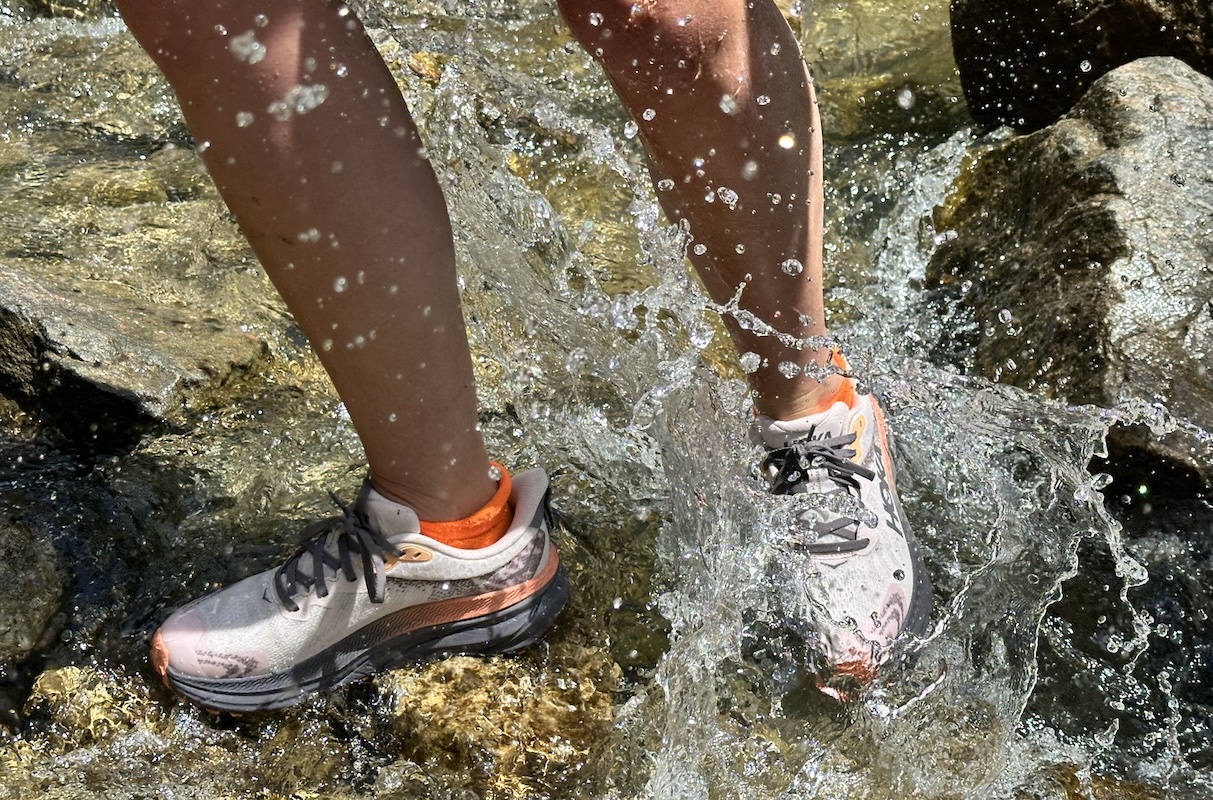
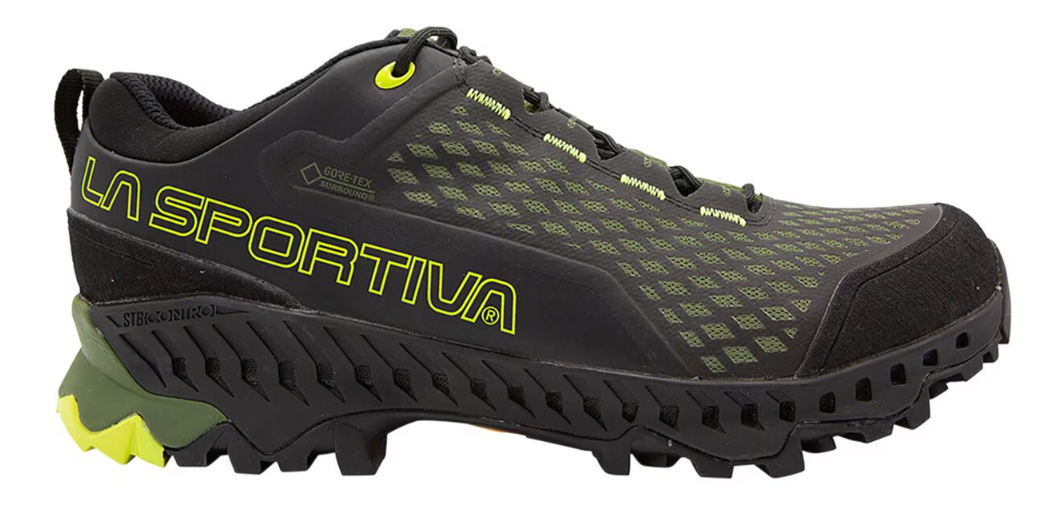 Category: Hiking shoe
Category: Hiking shoe
Weight: 1 lb. 15.0 oz. (men's), 1 lb. 10.2 oz. (women's)
What we like: A supportive, technical shoe with durable construction and excellent traction.
What we don’t: Expensive and a bit heavy.
While we appreciate waterproof trail runners, sometimes the expedition calls for a truly sturdy hiking shoe. That's where La Sportiva's Spire GTX comes in, with a rugged and protective midsole, deep, multidirectional lugs for incredible grip on a variety of technical terrain, and a foot-hugging upper that encourages a stable foot plant. To achieve this support, the Spire has a stiffer underfoot feel, which can take some getting used to. But the combination of midsole height and density does an excellent job isolating the feet from rooty, rocky trails, and the grip takes notes from La Sportiva's famed approach shoes for added security on steep rocks.
This shoe isn't the most versatile on our list, though, and wouldn't be our first choice for anything non-technical. At nearly 2 pounds (and over a pound and a half for the women's), it's on the heavier side for a hiking shoe, and while the higher cut is supportive, it might rub or feel binding to some people. Additionally, we sometimes prefer our waterproof hiking shoes to stay on the lighter side since we're already losing some breathability and flexion with the waterproof membrane, so this feels like a lot of shoe for casual use. These issues aside, it’s hard to knock the performance or quality of the Spire, and for those looking for a secure and capable waterproof hiking shoe, this one should be on your short list.
Read more: La Sportiva Spire GTX review (men's version)
See the Men's La Sportiva Spire GTX See the Women's La Sportiva Spire GTX
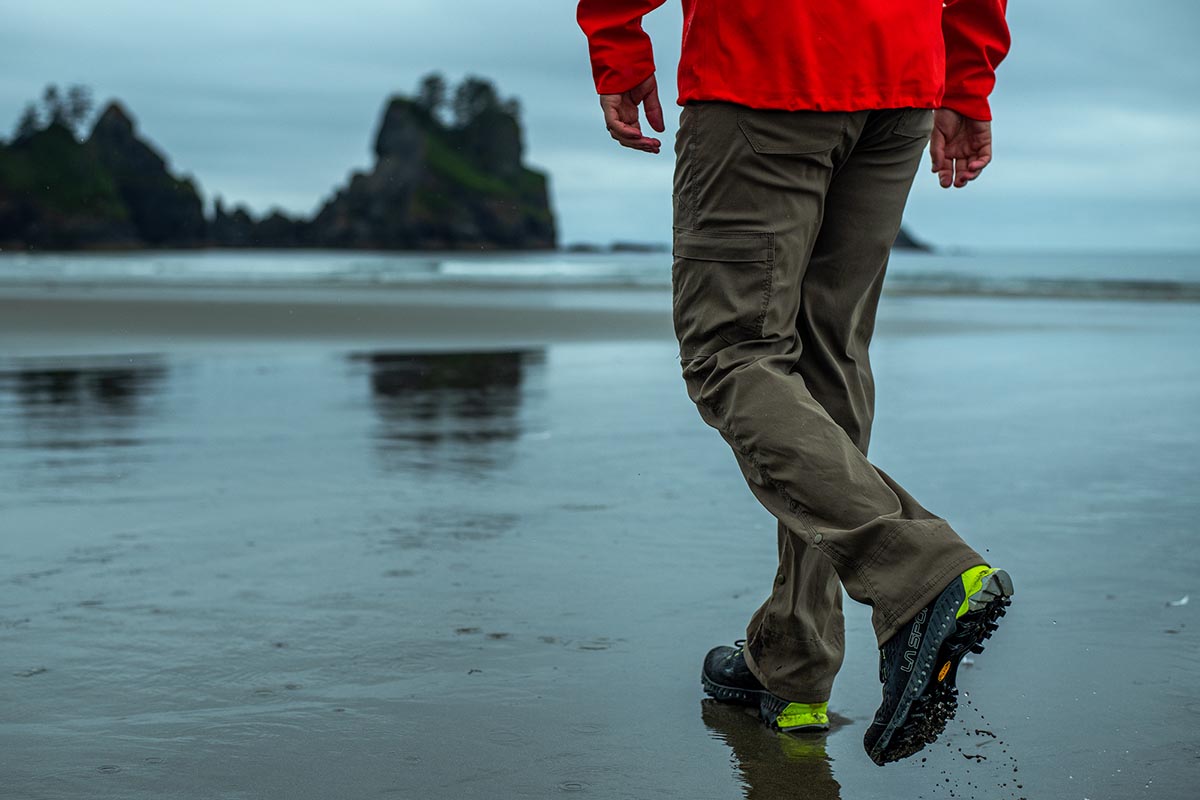
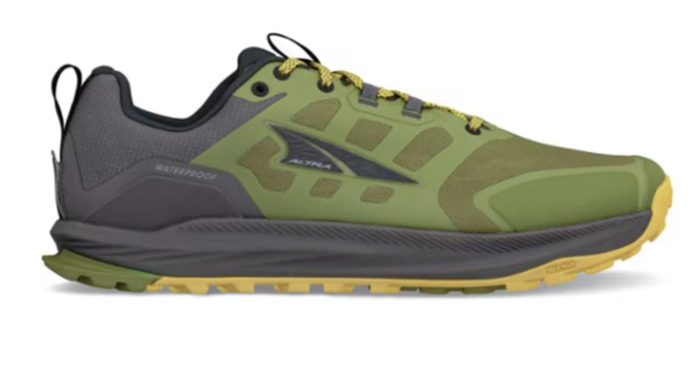 Category: Trail running shoe
Category: Trail running shoe
Weight: 1 lb. 11.7 oz. (men's), 1 lb. 6.6 oz. (women's)
What we like: A backpacker favorite thanks to the generous fit and zero-drop design.
What we don’t: Roomy fit and loose collar aren’t ideal for off-camber terrain; prone to durability issues.
Altra's Lone Peak is one of the brand's flagship shoes, complete with the signature zero-drop construction and wide toe box. Initially a trail running shoe, the Lone Peak was co-opted by thru-hikers for its comfort over long distances and excellent ground feel thanks to the conservative 25 millimeter stack height. The Lone Peak 9 Waterproof is a natural continuation of the original Lone Peak RSM (Rain Snow Mud) along with the discontinued All-Wthr. This latest waterproof update has a more durable membrane that's not as prone to cracking as the previous versions, and features a sleek overlay with less stitching and attachment points (another part that was prone to splitting in years past).
The Lone Peak is one of our top recommendations for people prone to blisters or pressure points caused by stiffer shoes, and the zero-drop design helps encourage a mid-foot strike, which can alleviate pain in the ankles, knees, and ligaments. Where these shoes have consistently fallen short for us in the past is with durability, seen in toe cap failures, worn-out tread, and splitting uppers after less than 100 miles during some of our test hikes (on past versions, we're still putting miles on the 9). And while the 9s have updated lacing and a more secure heel counter, we do find these uppers to lack support in the name of a wider design, so super technical trails may not be your best bet. But for comfort over long distances in a lightweight, breathable, and waterproof shoe, the Lone Peak is tough to beat.
See the Men's Altra Lone Peak 9 Waterproof See the Women's Altra Lone Peak 9 Waterproof
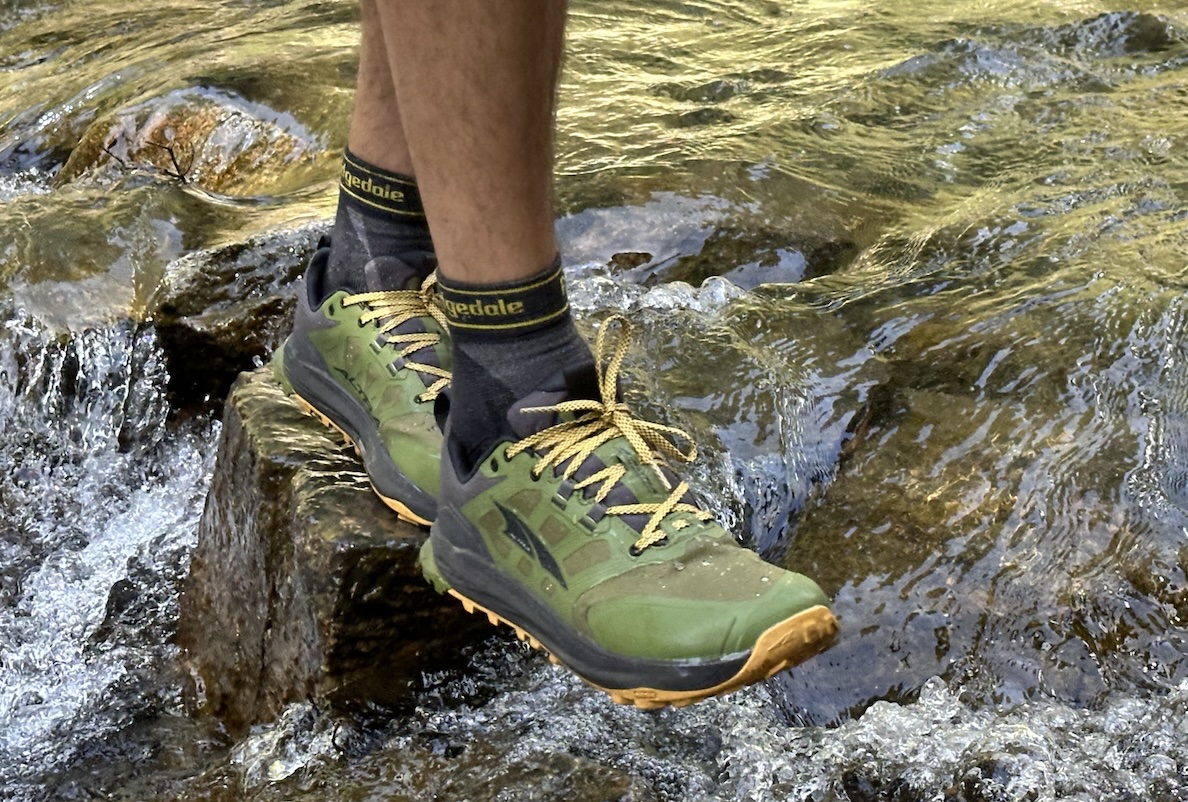
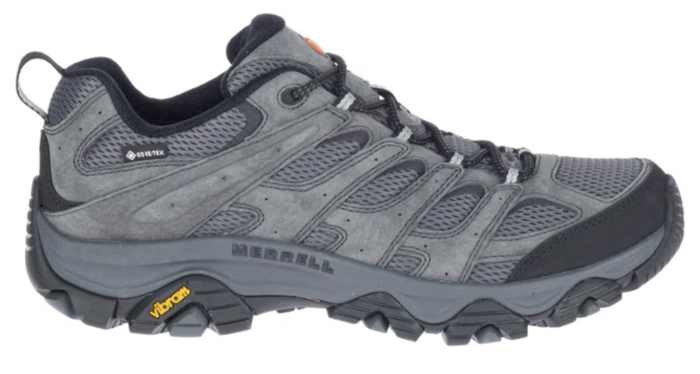 Category: Hiking shoe
Category: Hiking shoe
Weight: 1 lb. 9.9 oz. (men's), 1 lb 5.2 oz. (women's)
What we like: A very comfortable and well-built hiking shoe.
What we don’t: Somewhat outdated style; less breathable than other waterproof hiking shoes
These may not be the most stylish shoes, but Merrell's Moab 3 holds a strong corner of the market for a reason, and the Gore-Tex version adds an updated layer of protection compared to their in-house waterproof membrane. The Moab 3 has a stable, plated feel with generous underfoot padding and burly grip from the 5 millimeter lugs and Vibram outsole. This is a classic hiking shoe that hasn't been updated too much since its debut, but the 3 did see an increase in recycled materials, an updated insole, and modest updates to cushioning and traction. Aside from being a reliable, comfortable, waterproof hiking shoe, the Moab 3 is long-lasting and durable.
In terms of downsides, on rocky and muddy trails, we’ve found that the Moab 3 GTX's traction and stability fall short of performance shoes like Salomon's X Ultra 5 and La Sportiva's Spire above, though it does offer more stability than a trail-running model like the Lone Peak. While the Moab 3 GTX is not as breathable as sleeker trail running shoes, the ample mesh sections around the nubuck leather offer a reduction in ounces and an increase in air flow. The Moab 3 GTX is just one option in the wide-ranging Moab line, which includes a non-waterproof version, high-cut boots, and the aforementioned in-house waterproofing (called Merrell DRY), which is $20 less than the Gore-Tex version.
See the Men's Merrell Moab 3 Gore-Tex See the Women's Merrell Moab 3 Gore-Tex
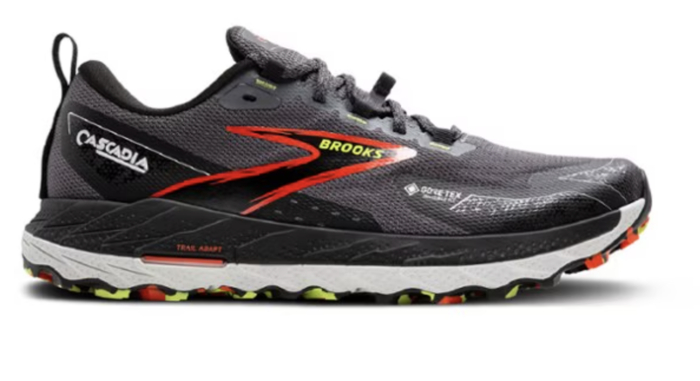 Category: Trail running shoe
Category: Trail running shoe
Weight: 1 lb. 7.2 oz (men's), 1 lb. 4.4 oz. (women's)
What we like: A classic thru-hiking shoe that offers more stability than the Lone Peak above.
What we don’t: Not as durable with less aggressive traction than true hiking shoes.
Now in its 18th generation (with the 19th coming very soon), the Brooks Cascadia is one of the longest-standing trail runners on the market and quite popular in the thru-hiking community. Like the Lone Peak above and Peregrine below, this shoe bridges the gap for speed-focused hikers with the support and protection you need for fast-and-light trails alongside a flexible upper and well-cushioned midsole. The Cascadia 18 GTX has a sleek, waterproof membrane that adds a nominal amount of weight (the men's GTX weighs 11.6 oz. per shoe, while the non-GTX weighs 11.1 each). The Cascadia's design is known for feeling stable and precise on off-camber terrain without losing agility and responsiveness, and we recommend this shoe for hikers with picky feet—similar to the Lone Peak above.
For hikers looking for a flexible, waterproof shoe for long distances on moderate terrain, we'd be more likely to recommend the roomy toe box of the Lone Peak, as the narrower forefoot on the Cascadia can feel compressive after long distances. But both shoes feel breathable and lightweight, and the waterproofing doesn't feel overly stiff despite the added protection. Like other trail running shoes, the Cascadia has a lower cut, so the waterproofing will only do so much if you're stomping through puddles and streams—you'll want to keep the water level below the top of the shoe to stay dry. Anything deeper, and the water coming over the top of the shoe will quickly saturate the interior, and these take longer to dry than non-waterproof trail shoes.
See the Men's Brooks Cascadia 18 GTX See the Women's Brooks Cascadia 18 GTX
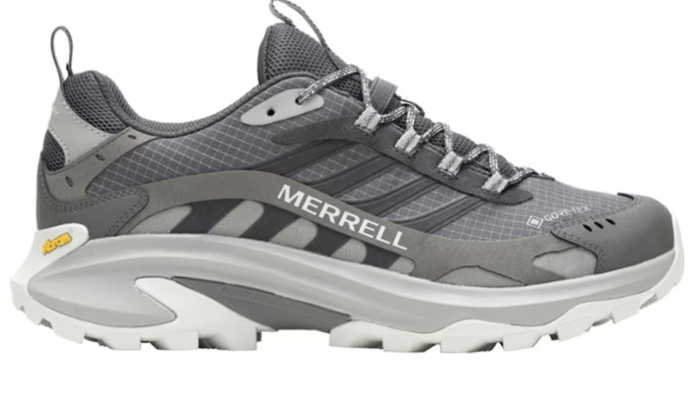 Category: Hiking shoe
Category: Hiking shoe
Weight: 1 lb. 8.7 oz. (men's), 1 lb. 5.2 oz. (women's)
What we like: Well-rounded on-trail performance with a firm but comfortable midsole.
What we don’t: A step down in durability and support from a traditional hiker.
Merrell's recent waterproof update to the Speed 2 continues to bring the iconic Moab line into the modern era. The Speed 2 has a nicely cushioned design that will appeal to hikers looking for a low-top shoe with the foot support of a boot, minus the constricting ankle collar. This isn't the lightest shoe on our list, but for the support in the 34-millimeter midsole, burly toe cap, and hefty heel counter, it does a good job keeping the ounces down. It has a lighter yet more cushioned midsole than the Moab 3 Gore-Tex above, shaving over one ounce off the weight, and uses the same reliable membrane.
Merrell designed this shoe to toe the line between a hiking shoe and a trail running shoe, and they were reasonably successful. This isn't as light and nimble as the Brooks Cascadia 18 GTX above or the Saucony Peregrine 15 GTX below, but it does have a more responsive, flexible feel than a burlier hiking shoe like its own sibling in the Moab 3 Gore-Tex above. Overall, we love the firm, planted feel of this shoe and appreciate its solid middle-of-the-road build—it doesn't quite specialize in any one thing.
Read more: Merrell Moab Speed 2 GTX review (women's version)
See the Men's Merrell Moab Speed 2 Gore-Tex See the Women's Merrell Moab Speed 2 Gore-Tex
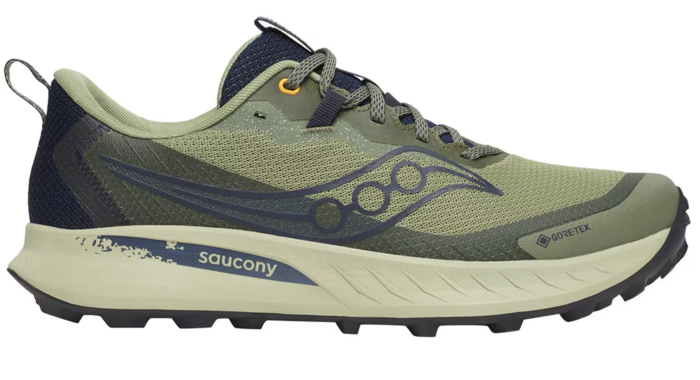 Category: Trail running shoe
Category: Trail running shoe
Weight: 1 lb. 5.0 oz. (men's), 1 lb. 2.4 oz. (women's)
What we like: Trail runner-like agility with a boost in protection and stability.
What we don’t: Not as light as trail runners like the Hoka Challenger above; can feel tight at first.
The long-standing Peregrine is an excellent choice for a range of environments and hike durations, and has some of the best traction of any shoe we tested in both the trail running and hiking shoe categories. It provides confident foot plants on climbs, and the deep lugs allow for secure downhills, even when loaded down with a pack. We wouldn't call this a particularly well-cushioned shoe (especially compared to Saucony's own Xodus 3 or the max-cushioned Hoka Challenger 7 GTX above), but the 28-millimeter heel stack feels protective without losing energy or rebound. This is our shoe of choice for combo hike-and-run outings, and it performs well across a variety of terrains.
We will say the Peregrine isn't the most comfortable shoe we've ever worn, and it can feel stiff and constricting out of the box. This is somewhat unusual for a trail running shoe, and while it breaks in fairly quickly, the GTX version does retain some uncomfortable tightness through the upper. The breathability is decent for a waterproof shoe, but we found the Cascadia 18 GTX above to feel more breathable and nimble overall, though the Peregrine has better foot-hugging support and resulting stability.
See the Men's Saucony Peregrine 15 GTX See the Saucony Women's Peregrine 15 GTX
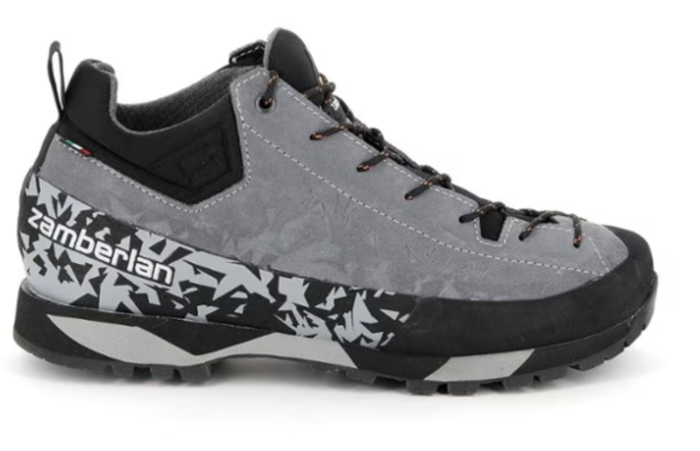 Category: Approach shoe
Category: Approach shoe
Weight: 1 lb. 15.4 oz. (men's), 1 lb. 10.8 oz. (closest women's equivalent)
Upper: Suede
What we like: Impressive durability; good ankle and underfoot support for long days in the mountains; can be resoled.
What we don’t: Heavy, expensive, upturned toe detracts from precision; less versatile.
Zamberlan’s Salathe GTX RR is an approach shoe with a slightly taller profile than your typical, standard low-cut hiking shoe. We were impressed by the craftsmanship and attention to detail, including a durable suede upper and generous rubber rand that showed few signs of wear after a full season of use. The Salathe also uses a Gore-Tex Extended Comfort liner that does a decent job regulating heat while providing good waterproofing. The fit is also impressive, and we’ve had no trouble customizing the tightness for more precise scrambling or loosening the laces after a long day. The toe box has adequate room for a variety of foot shapes, and accounts for swelling during long approaches (though some testers have reported the shoes feeling tight).
In our experience, the biggest issue is the upturned forefoot, which results in less precision when toeing in on small edges or smearing across slabs. Coupled with the hefty weight at nearly 2 pounds, these shoes have a relatively clunky feel compared to most non-approach hiking shoes, and we'd recommend them mostly for rock climbing approaches or particularly steep, rocky hikes. And then there’s the $280 price tag, which will be out of reach for many. But for mountain athletes who prioritize long-term durability and support, we’ve been really impressed with performance and durability from the Zamberlan brand. It’s also sold in a true mid-height boot version for $50 more. While there isn't the same version available for women, the Circe Low GTX comes close and is $40 cheaper.
See the Men's Zamberlan 215 Salathe GTX RR See the Women's Zamberlan Circe Low GTX
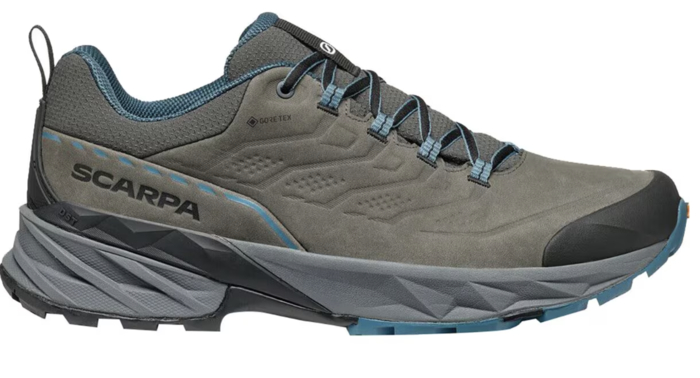 Category: Hiking shoe
Category: Hiking shoe
Weight: 1 lb. 12.2 oz. (men's), 1 lb. 7.2 oz. (women's)
What we like: Efficient rockered outsole for fast missions paired with TPU reinforcements for stability.
What we don’t: A bit pricey and not as light as true trail runners.
Scarpa’s Rush 2 Pro GTX is a prime example of the running-shoe-meets-hiking-shoe blend for hikers who want to move fast on the trail but seek more support than many lightweight trail running shoes provide. The Rush 2 Pro GTX has the cushion and rocker of a trail runner, but in a more built-up shoe with a durable, reinforced upper and sticky outsole that maintains traction on steep trails and loose rocks. The TPU reinforcements and torsion frame at the heel encourage a stable push-off on uneven terrain, all coming together for an excellent option for people seeking the responsiveness of a trail running shoe without losing the support of a hiking shoe.
We wore the first-generation Scarpa Rush while trekking in southern Patagonia and were impressed with its prowess on everything from hardpacked trail to talus. Our main gripe was the shoe’s low collar and poor ankle lock, but the 2 offers a noteworthy improvement with increased stability and torsion control through the heel. The Rush 2 Pro GTX is on the heavier side and wouldn't be our first choice for a combo run-hike mission, but it does feel lighter than its true weight thanks to the responsive, nimble outsole and midsole design. Overall, we love this shoe for speed-focused hikers and fastpackers, and the boost in stability and protection is clear when compared to standard trail running shoes.
See the Men's Scarpa Rush 2 Pro GTX See the Women's Scarpa Rush 2 Pro GTX
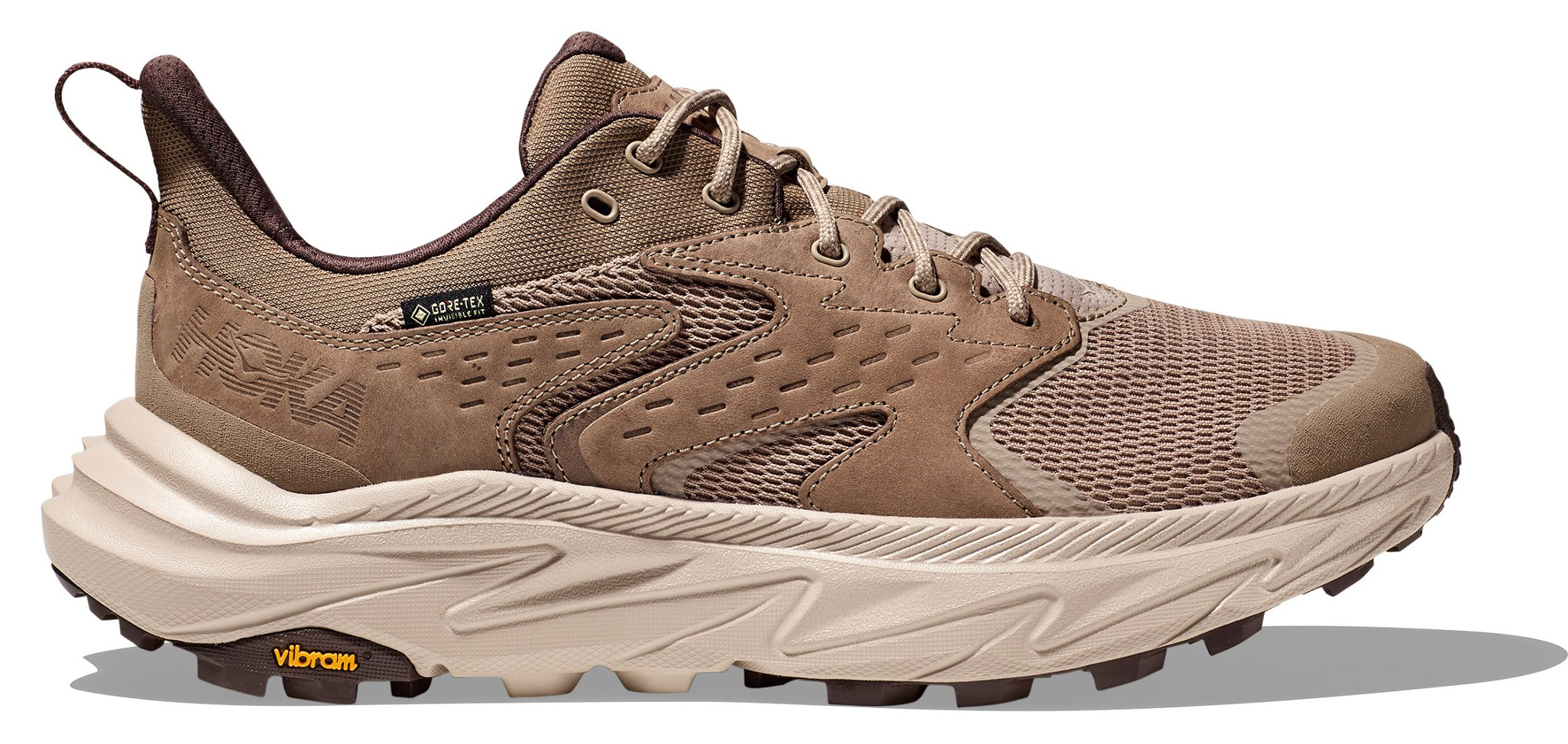 Category: Hiking shoe
Category: Hiking shoe
Weight: 1 lb. 14.6 oz. (men's), 1 lb. 8.8 oz. (women's)
Waterproof: Gore-Tex
What we like: Cushy design is extremely comfortable; smooth ride.
What we don’t: Some outsole durability issues, polarizing looks, fit runs big.
While Hoka's Speedgoat line has achieved icon status among backpackers and hikers, people looking for a more supportive hiking shoe without the tradeoffs of a trail runner should consider the Anacapa 2 GTX. This is an excellent option that takes the best hiking-oriented features from the Speedgoat and pairs them with a more durable construction and support, using Hoka's springy midsole and an enhanced rocker shape for excellent forward propulsion. The Anacapa has a heavier-duty build compared to the Hoka Challenger above, with a nubuck leather upper and a relatively breathable Gore-Tex waterproof liner. This is a versatile, efficient shoe that mixes a trail runner-like feel with the added structure of a waterproof hiking shoe.
The recent update to the Anacapa included a focus on more sustainable materials, along with a pared-down heel counter, added padding through the tongue, and increased cushioning in the midsole. We found version 2 to be overall more comfortable than the outgoing version, and appreciate the enhanced protection with the more durable toecap. One update we'd love to see in the next version is a redesigned outsole, as the large sections of blown rubber lack durability on rocky, jagged terrain. Despite the less-than-durable outsole, we are impressed with the updates to the Anacapa and appreciate the high level of cushioning and protection that still feels nimble and quick on the trail.
Read more: Hoka Anacapa 2 Low GTX review (men's version)
See the Men's Hoka Anacapa 2 Low GTX See the Women's Hoka Anacapa 2 Low GTX
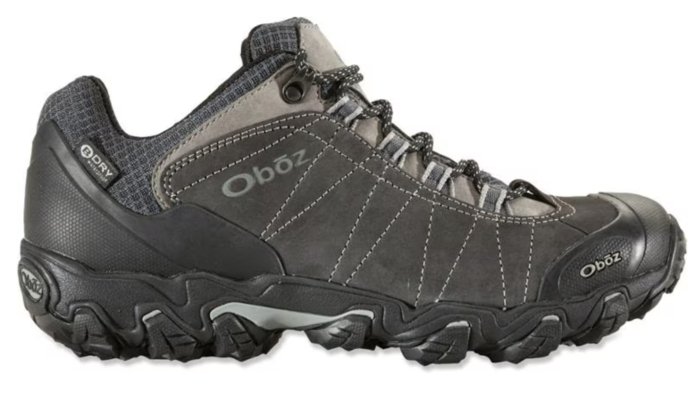 Category: Hiking shoe
Category: Hiking shoe
Weight: 2 lb. 3.4 oz. (men's), 1 lb. 11.6 oz. (closest women's equivalent)
What we like: A protective, rugged, supportive true hiking shoe.
What we don’t: Heavier and less breathable than the Moab 3 GTX above.
Based in Bozeman, Montana, Oboz has a reputation for making tough, trail-ready footwear for less than other comparable hiking shoes. The Bridger Low is a popular option in their classic hiking shoe category, favored by hikers carrying a heavy load and looking for something with a stiffer underfoot feel and burlier toe and heel protection over fast-and-light models. This shoe steers clear of the movement towards modernized, trail-runner combo hiking shoes, which keeps it lower on our list since it is heavier ands stiffer than most waterproof models we recommend, but still worth keeping here for people looking for something akin to a low-cut boot. This shoe uses a similar build to their higher-cut boots, with TPU chassis support for torsion control and the brand's proprietary B-dry waterproofing membrane.
That said, the Bridger Low isn't for everyone. It's significantly heavier than many modern hiking shoes, and we've found it to be less agile than almost everything else on this list. And with the durable nubuck upper, it has less breathability compared to the lighter, mesh-heavy waterproof hiking shoes above. The closest comparison on our list is the Merrell Moab 3 Gore-Tex; the Moab is more expensive, but it's also over 10 ounces lighter with better ventilation. However, for hikers looking for rugged underfoot protection and a sturdy build and who don't quite want to make the leap from a classic hiking boot to a lightweight modern hiking shoe, this is a great option. There's no precise women's equivalent to the Bridger Low, but the Firebrand II Low comes very close with almost identical specs.
See the Men's Oboz Bridger Low Waterproof See the Women's Oboz Firebrand II Low Waterproof
| Shoe | Price | Category | Weight (pair) | Waterproofing | Upper |
|---|---|---|---|---|---|
| Salomon X Ultra 5 Gore-Tex | $170 | Hiking shoe | 1 lb. 10.8 oz. | Gore-Tex | Synthetic |
| Keen Hightrail Waterproof | $145 | Hiking shoe | 1 lb. 11.9 oz. | Keen B.Dry | Nubuck, mesh |
| Hoka Challenger 7 GTX | $160 | Trail runner | 1 lb. 3.4 oz. | Gore-Tex | Mesh |
| La Sportiva Spire GTX | $209 | Hiking shoe | 1 lb. 15.0 oz. | Gore-Tex | Mesh, synthetic |
| Altra Lone Peak 9 WP | $160 | Trail runner | 1 lb. 11.7 oz. | Altra membrane | Mesh, synthetic |
| Merrell Moab 3 Gore-Tex | $180 | Hiking shoe | 1 lb. 9.9 oz. | Gore-Tex | Nubuck, mesh |
| Brooks Cascadia 18 GTX | $170 | Trail runner | 1 lb. 7.2 oz. | Gore-Tex | Mesh, synthetic |
| Merrell Moab Speed 2 GTX | $170 | Hiking shoe | 1 lb. 8.7 oz. | Gore-Tex | Synthetic |
| Saucony Peregrine 15 GTX | $175 | Trail runner | 1 lb. 5.0 oz. | Gore-Tex | Mesh |
| Zamberlan 215 Salathe GTX | $280 | Approach shoe | 1 lb. 15.4 oz. | Gore-Tex | Suede |
| Scarpa Rush 2 Pro GTX | $189 | Hiking shoe | 1 lb. 12.2 oz. | Gore-Tex | Synthetic |
| Hoka Anacapa 2 Low GTX | $180 | Hiking shoe | 1 lb. 14.6 oz. | Gore-Tex | Nubuck, mesh |
| Oboz Bridger Low WP | $160 | Hiking shoe | 2 lb. 3.4 oz. | Oboz B-dry | Nubuck, Cordura |
The Switchback Travel team is no stranger to long days on the trail. From epic high routes to months-long thru-hikes across the country, we clock serious miles each year on all sorts of terrain. This waterproof hiking shoe guide took inspiration from our original hiking shoe roundup, started back in 2015 and currently managed by senior editor and thru-hiker Chris Carter. For this waterproof-focused guide, contributing editor Maggie Slepian and editor-in-chief Penney Garrett dug into Switchback's continuously-updated library of testing notes to develop their initial list of candidates. Maggie added in her experience hiking in Montana for shoulder-season backpacking trips, plus thousands of miles of thru-hiking across varied terrain, and Penney weighed in from the variable weather of the Sierras where she's always hiking through something mucky with her pup in tow.
Our years of testing dozens of highly rated waterproof hiking shoes helped us narrow in on the selection of 13 competitive models above. We drew from personal experiences as well as feedback from seasoned contributors and the hiking community, considering a range of options from burly approach shoes to lightweight waterproof trail runners, all while taking into account breathability, waterproofing reliability, durability, traction, and comfort over long distances. If you're looking for a different style of hiking footwear, we took a similar approach in putting together our lists of the best hiking boots and best trail running shoes.
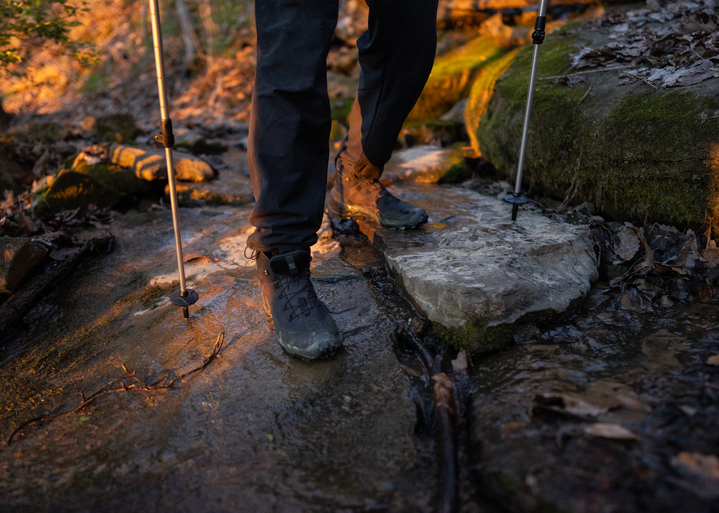
Waterproof hiking shoes are made with a waterproof, breathable membrane sandwiched between the outer shell fabric and the liner. The membrane itself is also three layers consisting of an expanded polytetrafluoroethylene (ePTFE) membrane bonded with a lining and knit backer. It might sound bulky and complex, but waterproofing and shoe materials are so advanced these days that many of the shoes above weigh just a few ounces more than their non-waterproof counterparts. Most of these hiking shoes use a Gore-Tex membrane, while a few brands (like Keen, Merrell, and Oboz) use their own in-house waterproofing membrane. For extra protection, waterproof hiking shoes are usually treated with a durable water repellent (DWR) coating. Though this treatment wears off over time, you can refresh it with an after-market spray like Nikwax.

While waterproof hiking shoes often aren't a true necessity, we see them as an added layer of security for outings with creek crossings, surprise rainfall, or hitting slushy snow on an early-season trek. Keep in mind the extra layer adds weight and impacts breathability, though we've found Gore-Tex models to balance all these elements the best. Many in-house membranes perform similarly at keeping water out, though they don't have the best breathability. In a nutshell, whether you need waterproof hiking shoes depends on your terrain, preferences, and expected conditions. Waterproof hiking shoes are excellent options for colder hikes, muddy trails, slush, moderate water crossings, and rainy weather.
For super wet or super dry conditions—think constant rain and water crossings or the dry desert—we actually don't recommend waterproof hiking shoes. Waterproof shoes, by nature, don't stay as cool and breathable as non-waterproof ones, so you'll feel hotter in the summer or in desert climates. On the other end of the spectrum, if you're hitting a trail with a lot of creek crossings or constant rain, your low-top waterproof hiking shoes might get saturated (though you can delay this soaking with a pair of gaiters). Since waterproof shoes have reduced airflow, they won't dry out as quickly, so you'll be stuck with wet shoes. This review includes are all low-top recommendations, so be sure the creeks you plan to cross aren't too deep— if you anticipate encountering deeper water, consider a pair of waterproof hiking boots instead. For a full breakdown on choosing footwear, check out our article on whether you need waterproof hiking shoes.
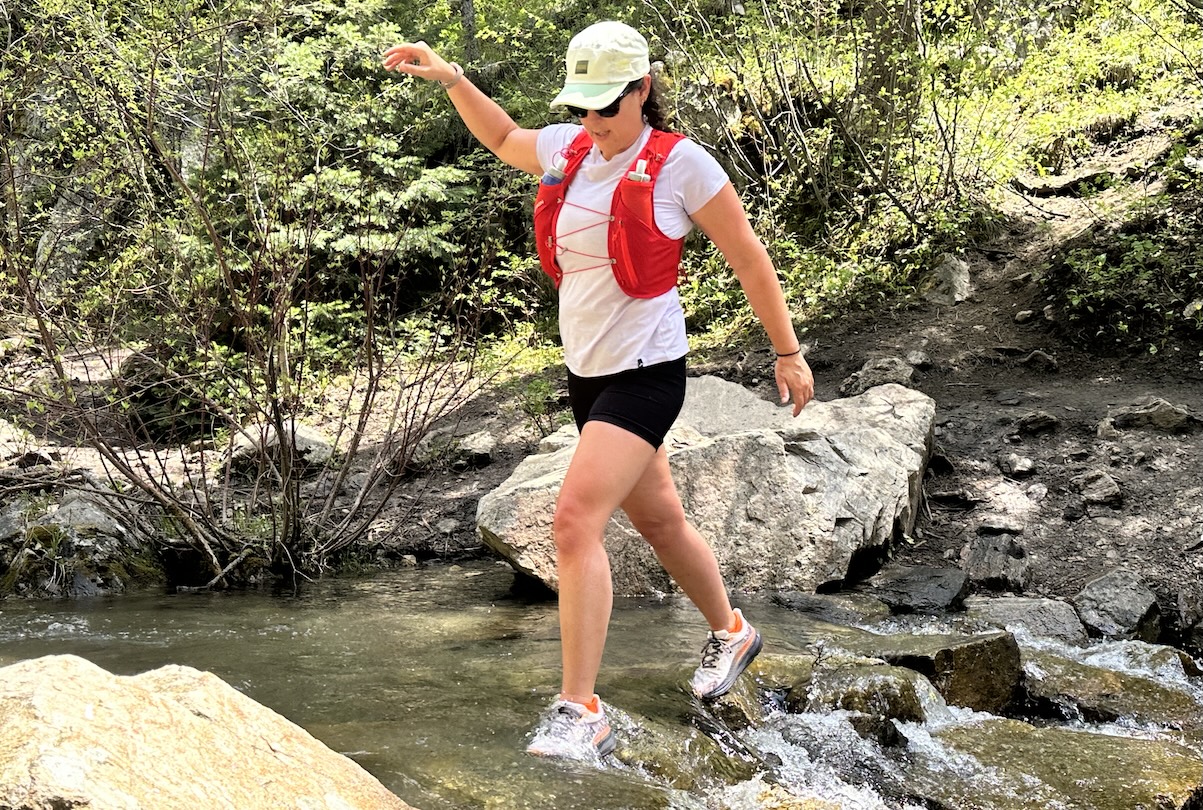
Cost
Many waterproof hiking shoes are also offered in non-waterproof versions, which can save you $15-25 over the waterproof model. For instance, the non-waterproof Hoka Challenger 7 costs $145, while the Gore-Tex model is $160. The $170 waterproof Salomon X Ultra 5 Gore-Tex is $20 more than its non-Gore-Tex counterpart, and the Saucony Peregrine 15 GTX costs a full $30 more than the original.
Breathability
No matter how much a brand brags about their waterproof membrane, the truth is that they don’t breathe well. While they do allow some moisture venting, waterproof and breathable membranes restrict a shoe’s ability to pull moisture away from your sweaty feet. Not all non-waterproof shoes should be treated equally, however. Just like non-waterproof shoes, footwear with thinner fabrics and a lot of mesh will increase moisture transfer and airflow, which will help your feet be less sweaty in hot weather.
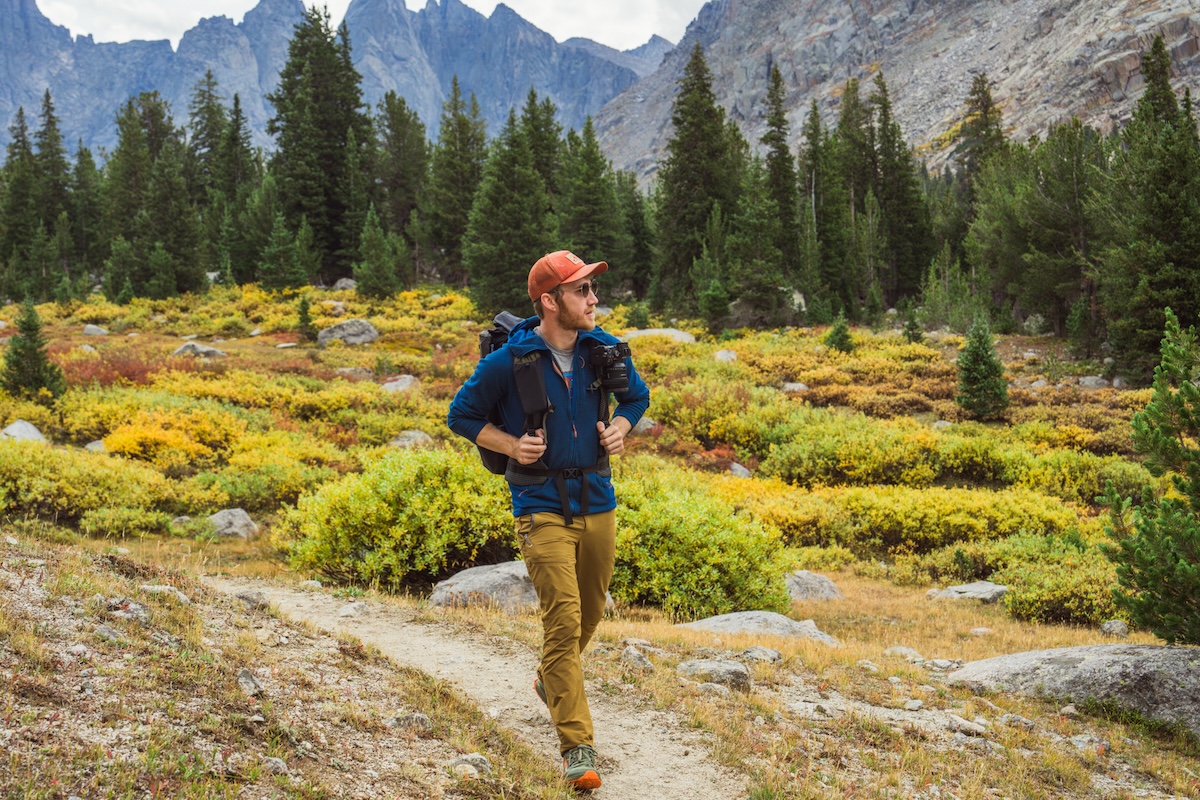
Weight
Waterproofing adds anywhere from a half-ounce to two-plus ounces per shoe. For instance, the non-waterproof men's Altra Lone Peak 9 weighs 11.15 ounces per shoe, and the waterproof versions weighs 13.85 ounces per shoe. The men's Salomon X Ultra 5 weighs 12.7 ounces per shoe, while the Gore-Tex version weighs just a bit more at 13.4 ounces per shoe.
Durability
Waterproof hiking shoes have an additional layer of upper protection from the DWR coating, which also helps repel grime and mud. This can increase the longevity of the uppers, and many true waterproof hiking shoes (as opposed to trail running shoes) are burlier in general. We have seen the waterproof membranes cracking or peeling in older models (especially with the Altra Lone Peak), but as the integration has improved, this has become less of an issue.
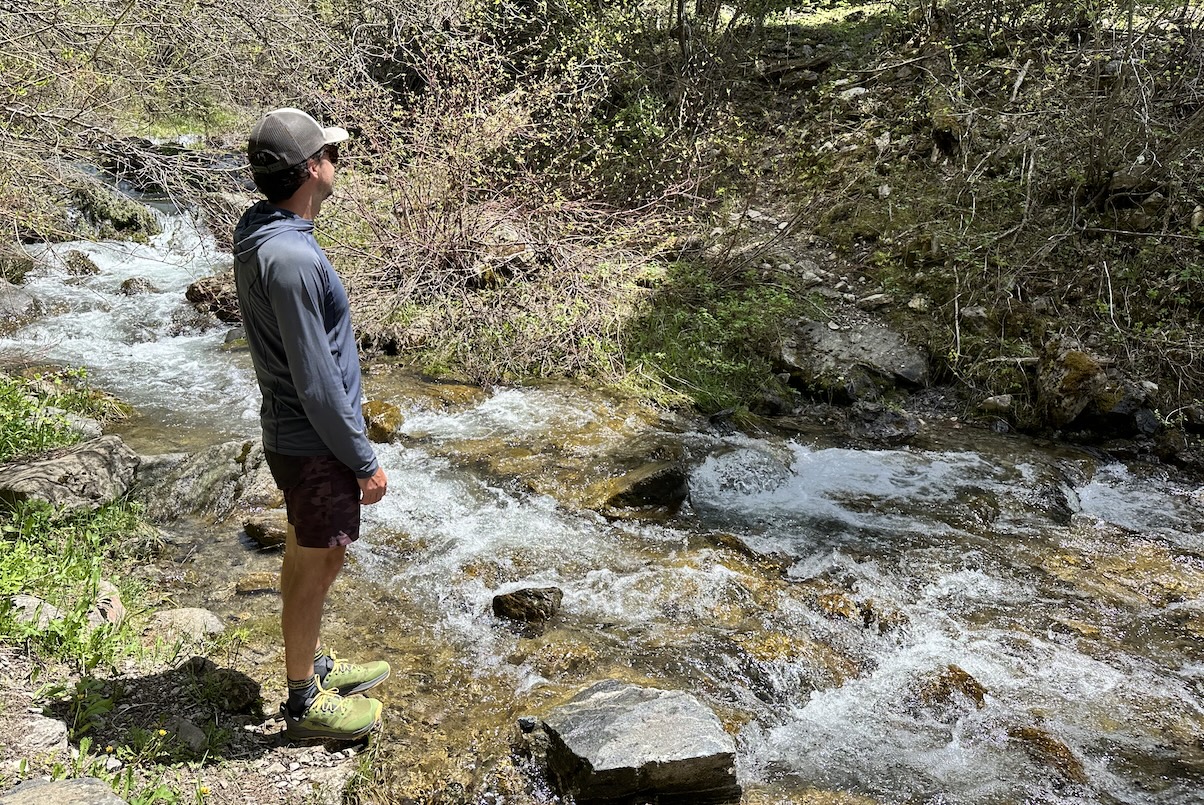
Protection
This is where waterproof hiking shoes really shine. With the waterproof membrane and additional DWR coating, waterproof hiking shoes offer protection against wetting out as well as a little extra warmth during cold hikes. For this reason, even if we don't anticipate an overly wet trail, we appreciate the boost of warmth on chilly days.
Hiking Shoes
For the vast majority of hikers, a below-the-ankle hiking shoe like the ones listed above are a good middle ground between boots and trail runners. Shoes like our top-rated Salomon X Ultra 5 GTX are stiffer and more substantial than a trail running shoe for carrying a light load, without the heaviness of a full-on boot. Hiking shoes also often have a tougher construction than trail running shoes, with more leather and durable nylons as opposed to mesh. Protection from obstacles like rocks and roots comes courtesy of rubber toe caps and medium-stiff midsoles. Hiking shoes are also great options for folks needing a substantial shoe for daily wear—just be mindful that the outsoles will wear faster on pavement than a dirt trail.
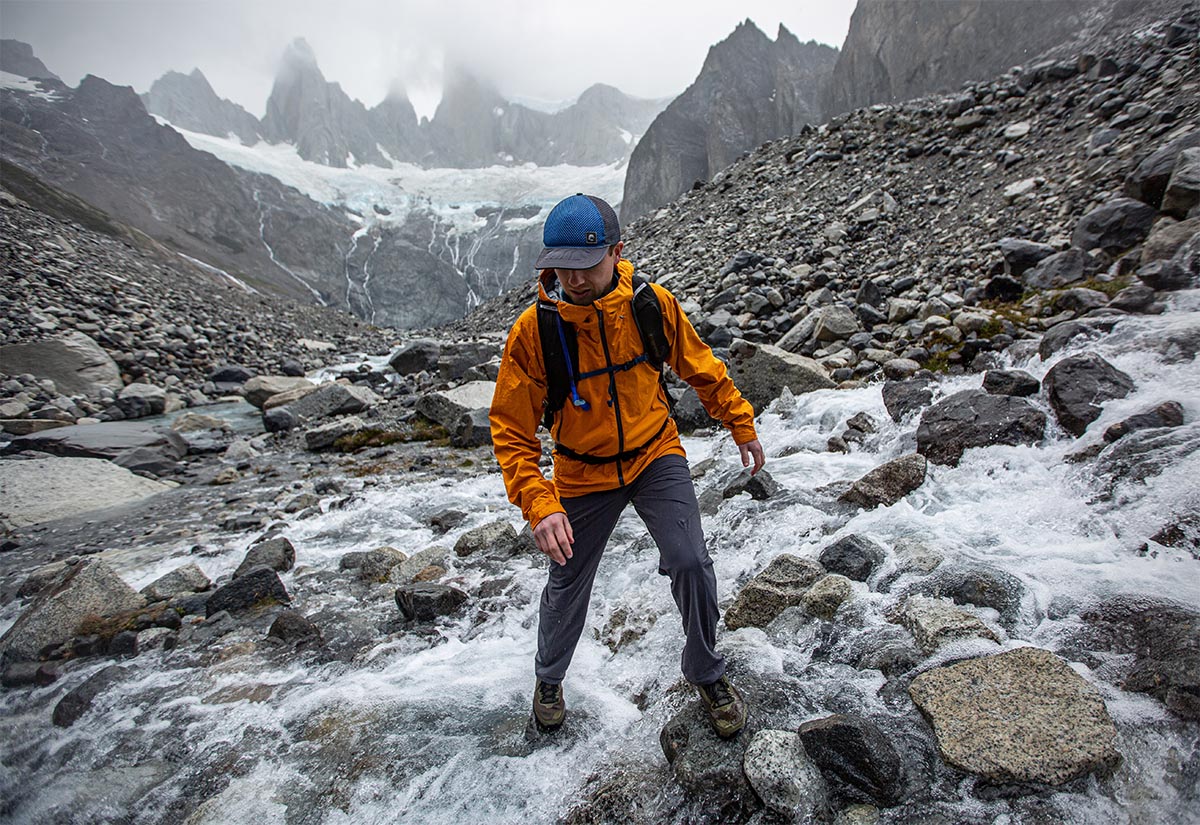
Trail Running Shoes
If moving fast is important to you, consider a trail running shoe. Models like the Hoka Challenger 7 GTX and Altra Lone Peak 9 Waterproof have gained significant popularity over the past few years in both the hiking and trail running community. That said, keep in mind that these types of shoes are not traditional off-trail or backpacking footwear. Trail runners are flexible and comfortable, but they don’t provide much in the way of ankle support when you’re carrying a heavy load, and they often have less toe and underfoot protection. For hikes on established trails or for experienced minimalist trekkers, however, a trail running shoe remains an excellent option. For a complete breakdown, see our round-up of the best trail running shoes, and for a deeper dive into the differences, check out our article on hiking shoes vs. trail runners.
Approach Shoes
This third option has a relatively narrow focus: climbers or hikers who need a grippy shoe to tackle steep and rocky terrain. Since these shoes are so specialized, we feature fewer of them on our list. Approach shoes like the Zamberlan 215 Salathe GTX RR are used by rock climbers on the hike in, and are swapped out for a true climbing shoe on the route itself. Approaches to climbs are often steep and technical, so the large toe rand and a sticky, low-profile rubber compound of an approach shoe helps achieve maximum grip on rock. The shoes can be plenty comfortable on day hikes, especially crossover styles like the La Sportiva TX4 Evo from our standard hiking shoe roundup, but we don't typically recommend them for daily hiking or backpacking.

One of the biggest changes in modern waterproof hiking shoe technology is the development of lighter designs. Tough but thin fabrics and a preference for low-top shoes have made it easier to hit big miles, and is an important reason many hikers choose a waterproof trail runner over a heavier hiking shoe. Most of the shoes on our list weigh 2 pounds or less for a pair, while a burly backpacking boot like the Asolo TPS 520 GV Evo tips the scales at over 4 pounds. And though lighter shoes are sometimes less durable, we appreciate the lighter weight for day hikes, fast-and-light backpacking trips, and peak bagging. As long as you aren't carrying a massive pack and choose a shoe with adequate stability for your terrain, you'll appreciate the lower weight.
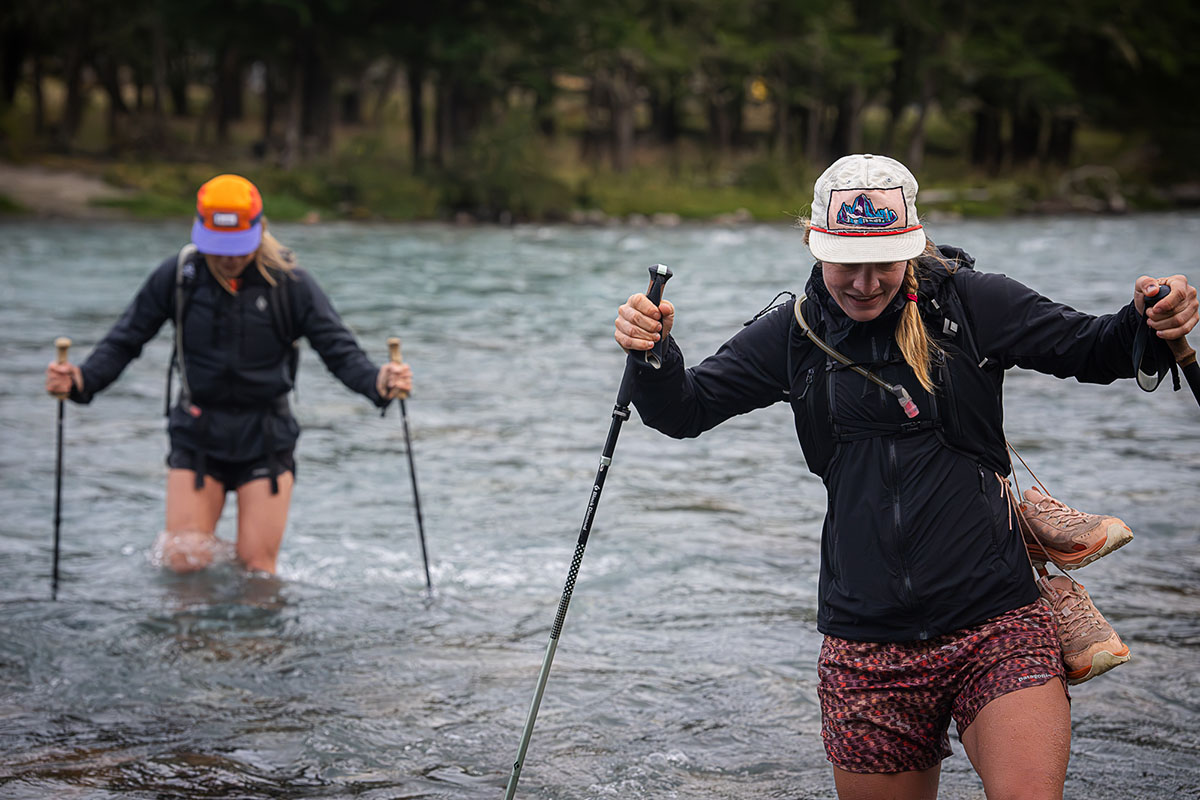
While all hiking footwear (excluding some minimalist trail runners) retains a degree of stiffness thanks to built-in shanks or internal supports, some will be more supportive than others. These features are part of what separates a hiking shoe (and approach shoe) from a flexible cross trainer or road running shoe.
For day hikes on flatter or less technical terrain, we love a good pair of lighter, somewhat flexible shoes like the Merrell Moab 3 and Keen Hightrail. As your trips get longer and your pack gets heavier, a more substantial shoe wins out for us. Look to the Salomon X Ultra 5 and the La Sportiva Spire for great all-around options that are equally adept at conquering summit peaks and multi-day backpacking. For more info, check out our section below on boots vs. shoes.
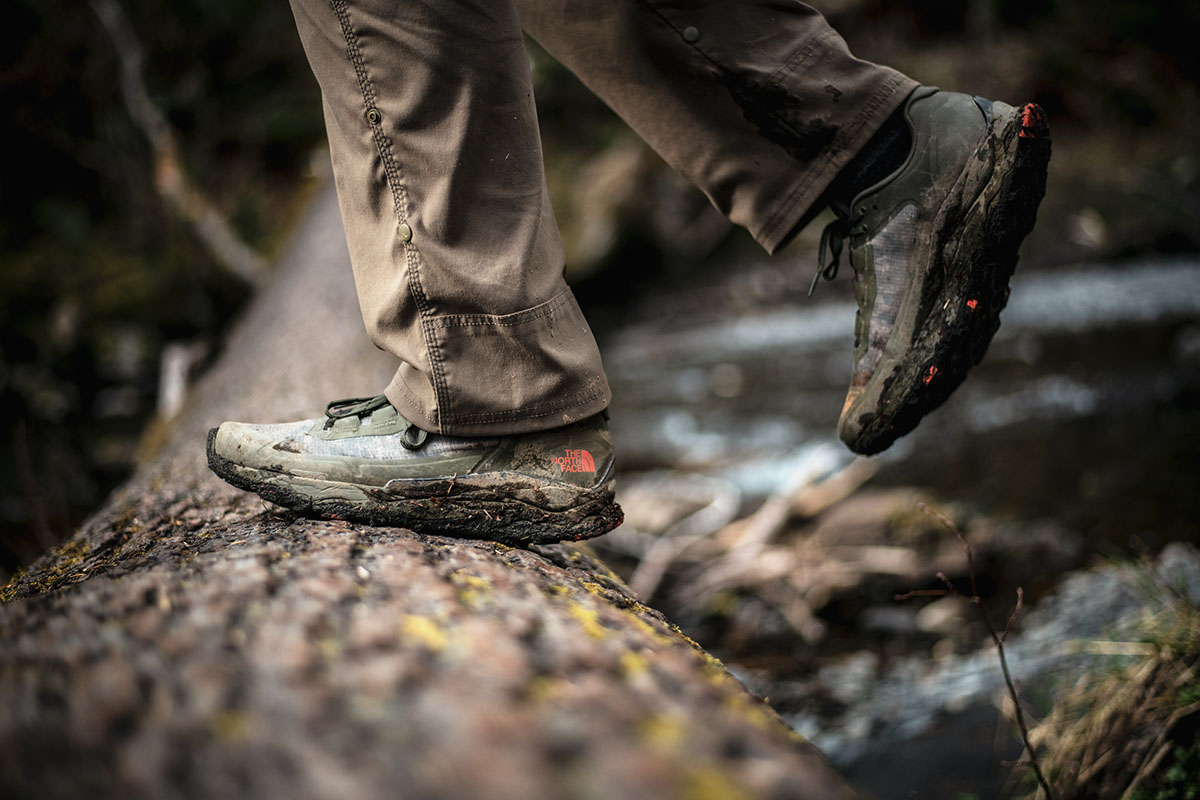
Hiking shoe upper material is not the most exciting topic, but understanding the construction can give insights into a shoe's performance. The type of material used will correlate directly with a shoe's durability, support, and breathability. Most hiking and trail shoes are made with a mix of nylon, mesh, and leather to balance cost, comfort, and longevity.
Synthetic Nylon and Mesh
Woven synthetic paired with synthetic mesh panels is what's commonly used to aid breathability. These materials aren't as durable, but they do a great job of cutting weight. Some of our favorite models with durable but lightweight synthetic mesh for standout breathability include Hoka's Challenger 7 GTX and Altra's Lone Peak 9 Waterproof—both of which have accompanied us on multiple thru-hikes. Waterproof hiking shoes (and especially trail runners) still have mesh overlays and upper components, but the added waterproof membrane layer means you retain full coverage without the same amount of air flow.
Nubuck Leather
Made of full-grain leather, but with a brushed finish that feels like suede, nubuck is a common sight on heavier-duty hiking shoes. The softer-touch leather is lighter and more flexible than traditional, glossy full-leather options and more durable than most nylons. It falls short in breathability, however. As a result, it’s common to find a mix of leather and nylon mesh for abrasion resistance and breathability, as seen on shoes like Hoka's Anacapa 2 Low GTX and Merrell's Moab 3 Gore-Tex. Neither of these shoes are overly heavy, proving it's possible to find a durable, supportive hiking shoe without weighing down your feet.
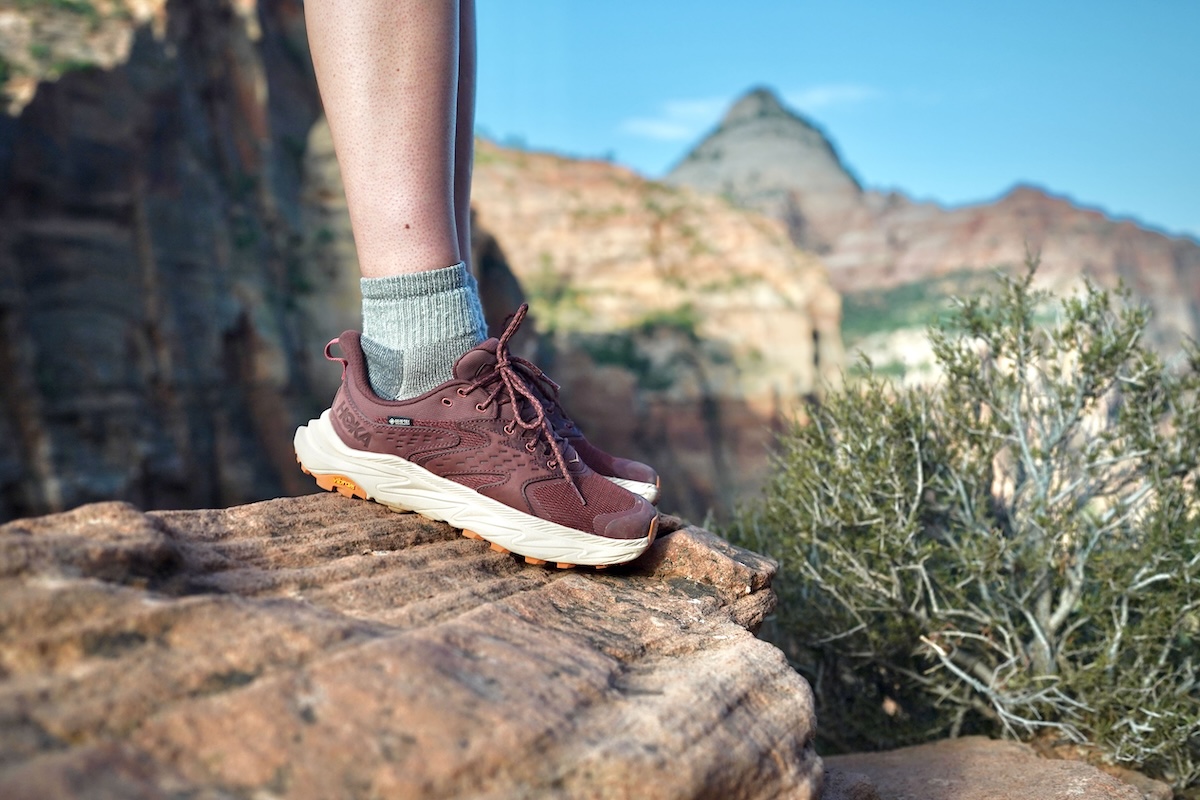
The midsole of a hiking shoe works as the primary underfoot cushion, acting as a shock absorber and providing an additional layer of protection from sharp rocks. Depending on the design, midsoles vary from very thin (as seen in a minimalist trail running shoe) to stiff and substantial (burly hiking shoe). Most include EVA, TPU, or a combination of both in their construction.
EVA
Foam EVA midsoles are a common sight on running and hiking footwear. The soft material takes some of the sting out of heel or midfoot impacts and is also extremely lightweight. While nearly all shoes on this list use some sort of EVA, the proprietary versions can vary from super soft to mildly stiff. For logging serious miles on tougher terrain, we prefer a firm and supportive midsole as opposed to too much cushioning. In general, you pay more for an improved midsole design and a higher-quality EVA compound.
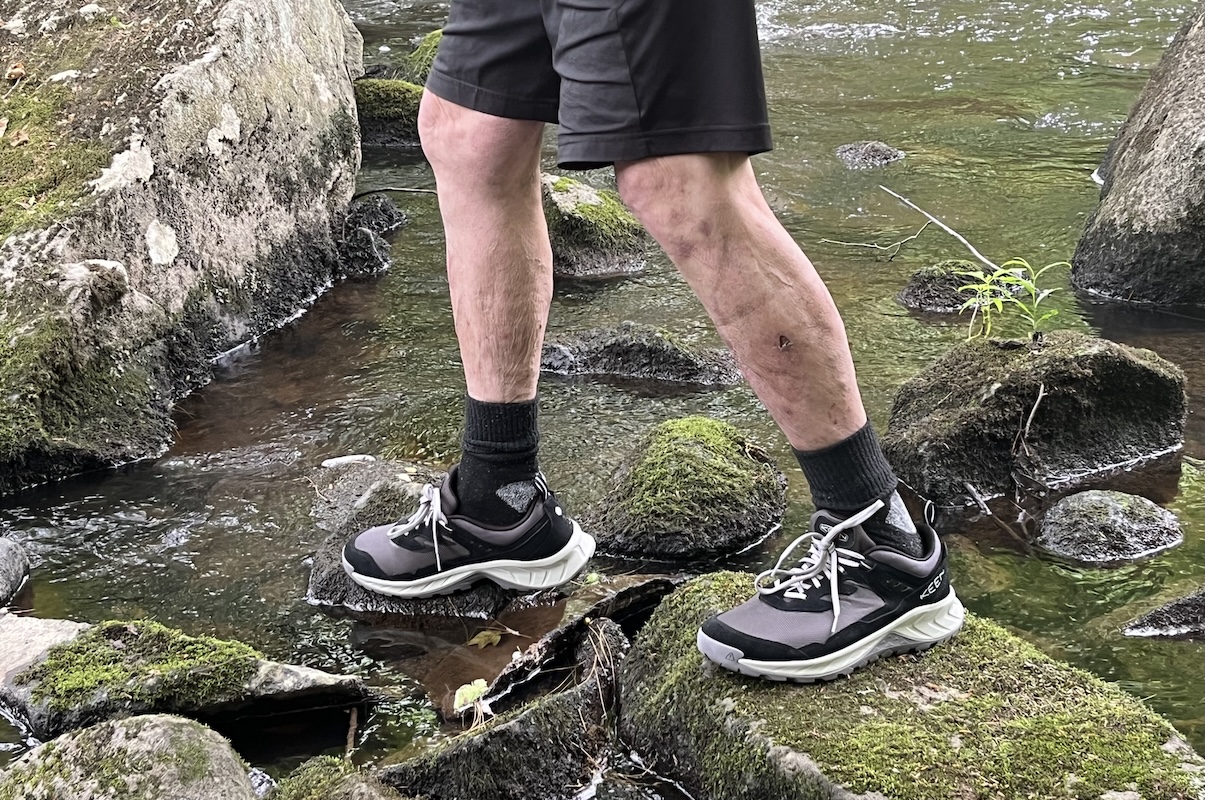
TPU
Thermoplastic polyurethane (TPU) is a durable plastic commonly found in performance-oriented light hikers. Shoes that use TPU underfoot are often less cushy than those with only EVA, but will last longer and can better handle a heavy load. In addition, they’ll keep their shape longer and won’t be prone to compressing like EVA. Because both midsole types have valid applications and TPU is more expensive, it’s common for a manufacturer to use a TPU frame or shank for stability and toughness and add EVA underfoot to increase comfort.
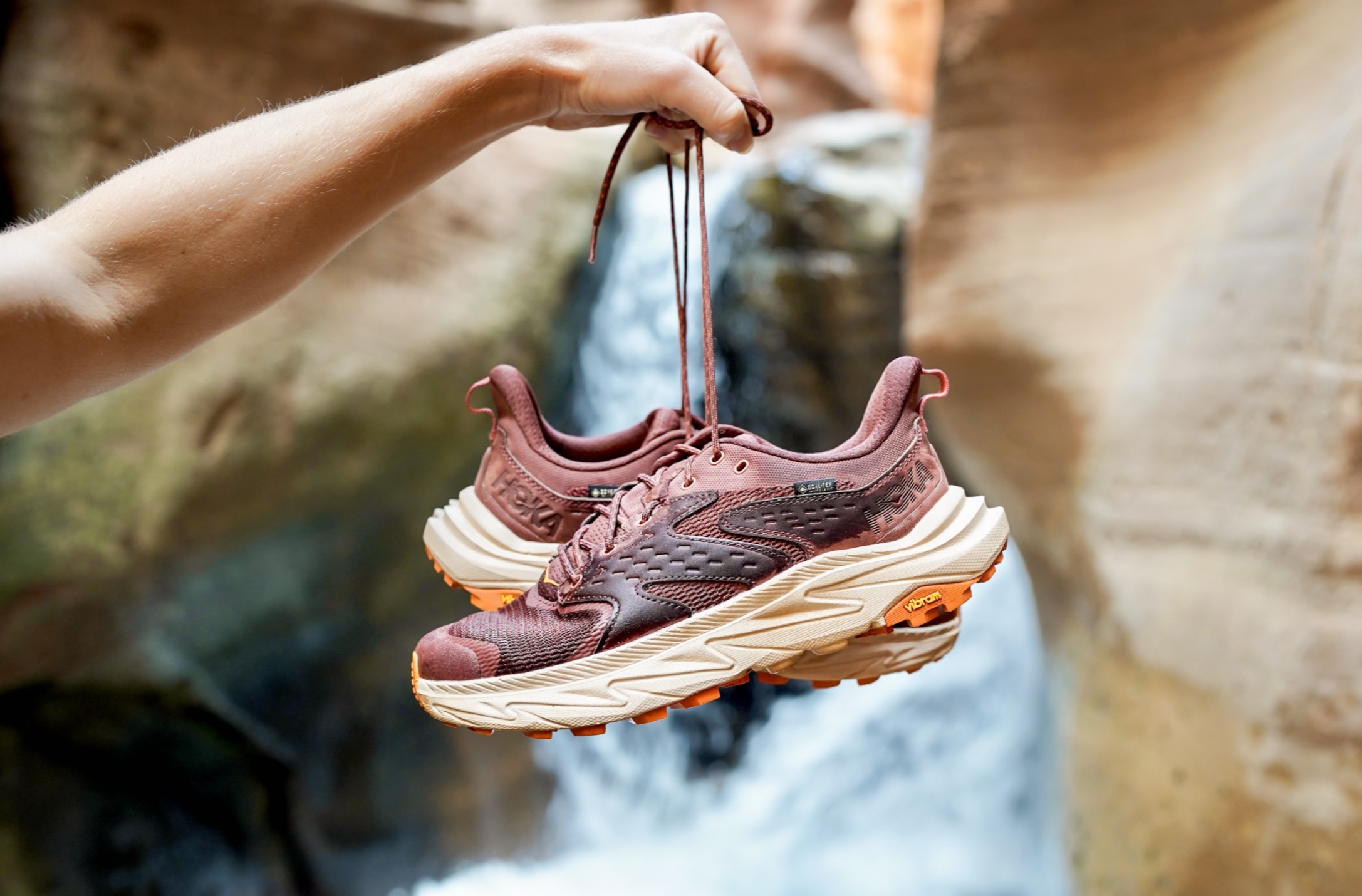
One of the main reasons to opt for a true hiking shoe or dedicated trail runner is the improved traction. Much like Gore-Tex dominates the market for higher-end waterproofing, Vibram inhabits a similar space for outsoles. The name is synonymous with solid grip and traction on a variety of terrain, and Vibram rubber is incredibly durable compared to other compounds we've tested. Not all Vibram models should be treated as equals, however, as the rubber manufacturer tailors its designs to the specific footwear and brand. Some have much larger lugs underfoot for serious grip in mud, and others prioritize sticky rubber for scrambling over rocks. There are also more moderate options that just do well on easier trails, like the lugs you’ll find on the bottom of the Merrell Moab Speed 2 Gore-Tex.

Many hiking trails are full of rocks, roots and other potential hazards, so we almost always recommend a hiking shoe with some type of toe cap. Lacking any protection on the front of your shoes can lead to trip-ruining impact when you inevitably look up from the trail to enjoy the scenery. Hiking shoes typically have a full rubber toe cap, but trail running shoes sometimes have a trimmed-down version or none at all—one of the compromises in opting for a minimalist shoe. Approach shoes, on the other hand, have exceptional toe protection with their wraparound rubber rand at the front of the shoe. Some trail runners have toe protection, but you'll most often find the heavier toe caps on a true hiking shoe like the Oboz Bridger Low.
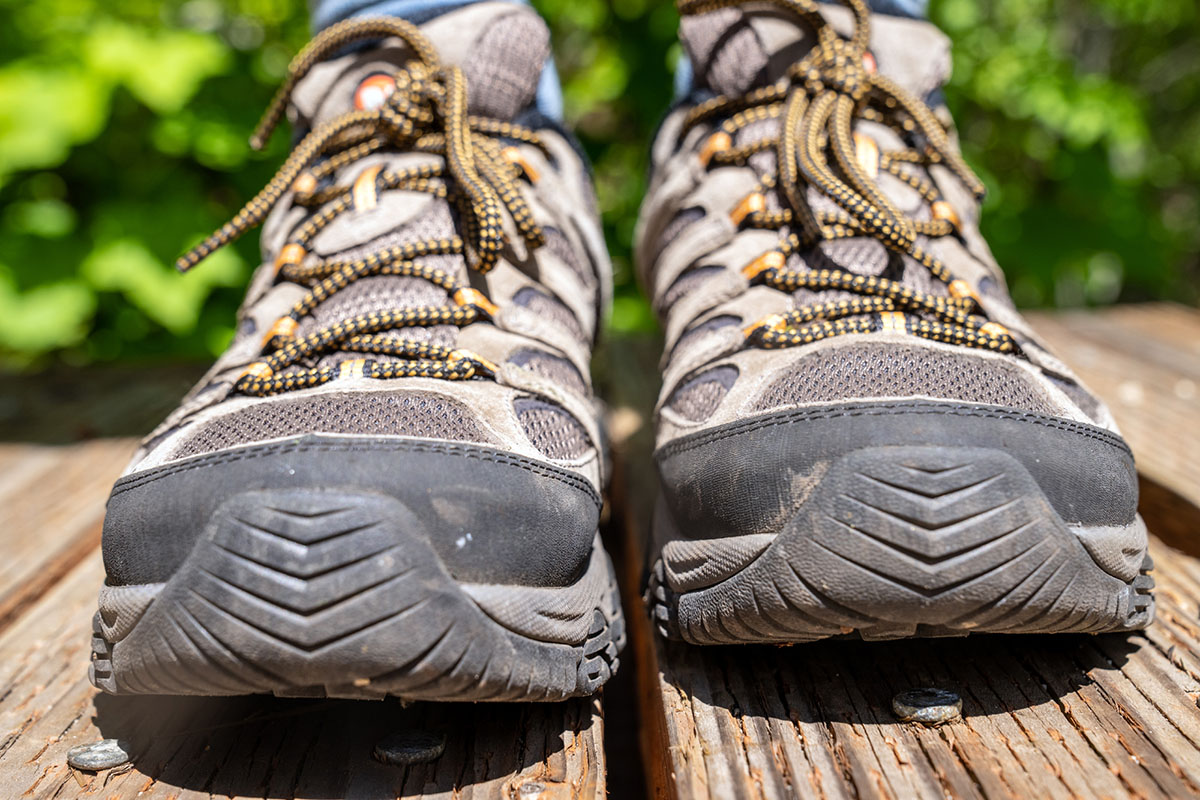
Perhaps the biggest point of differentiation between hiking shoes and boots is height: Shoes have a low-top fit, while boots generally sit above the ankle. Both boots and shoes offer plenty of waterproof models, but waterproof hiking boots add more protection for deeper stream crossings, and it's more common to see waterproofing in an over-the-ankle boot. Tradition tells us that hiking boots are the better choice for heavy packs and rough trails, and in most cases, that holds true. The tall height, along with laces that hold the boot snugly around your ankle, offers a more secure fit, greater stability, and added protection. That said, hikers can build up ankle strength in low-top shoes and remain quite safe traversing the same terrain that they would in boots. Given the choice, we usually prefer a waterproof hiking shoe for its lightweight and agile feel, but it's ultimately up to the individual.
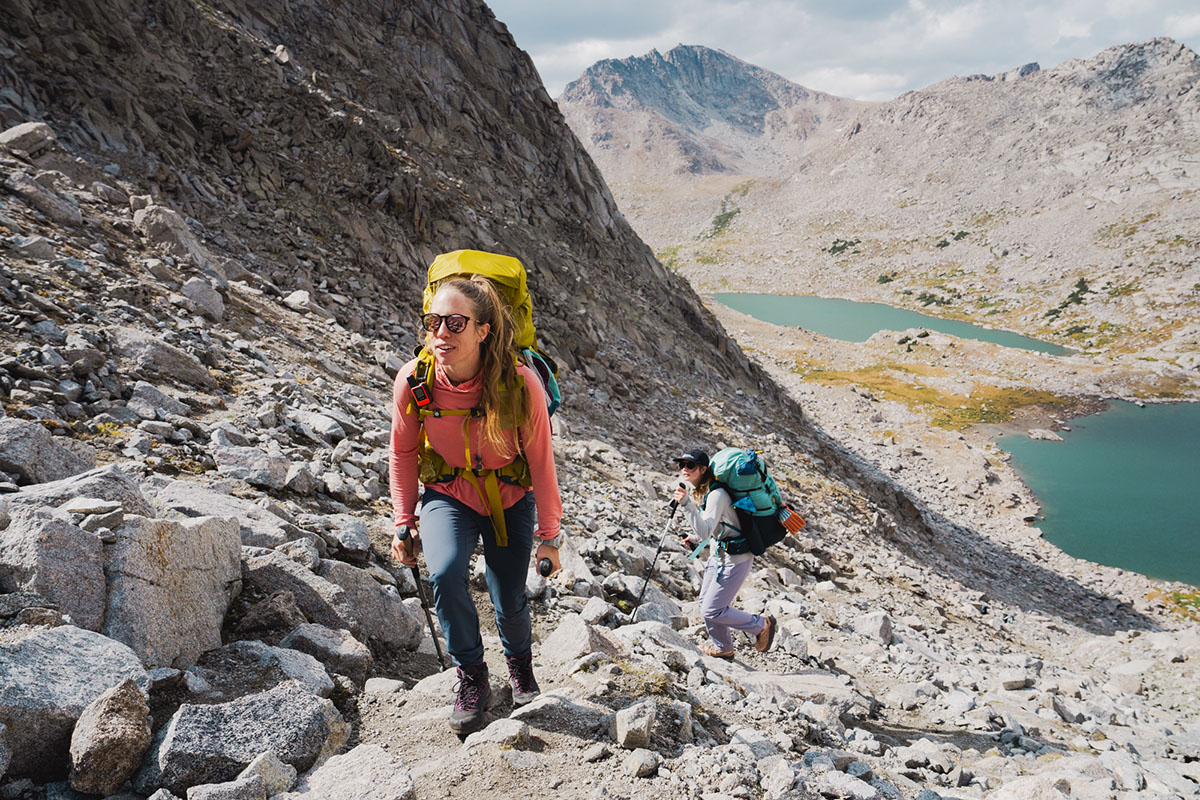
In 2025 and beyond, we see the lines between hiking shoe and boot categories continuing to blur. They still will be separated by height—although some modern boots only cover part of the ankle—but fewer boots resemble the heavyweight leather clunkers of years past. One example is the over-the-ankle version of our top-rated Salomon X Ultra 5 GTX. It’s essentially the same shoe body with the same defining characteristics—feathery feel, aggressive stance, and supportive fit—but the "Mid” sits slightly higher on the ankle, weighs a couple more ounces, and provides a boost in protection and support. Since most folks stick to defined trails, the push for this type of fast-and-light footwear will continue to take over the market.
Back to Our Top Waterproof Hiking Shoe Picks Back to Our WP Hiking Shoe Comparison Table